

Thunder
Ill. Brother Frank Lasick, 33°, and his service partner, Thunder, are tireless advocates for America’s VetDogs.
p 24
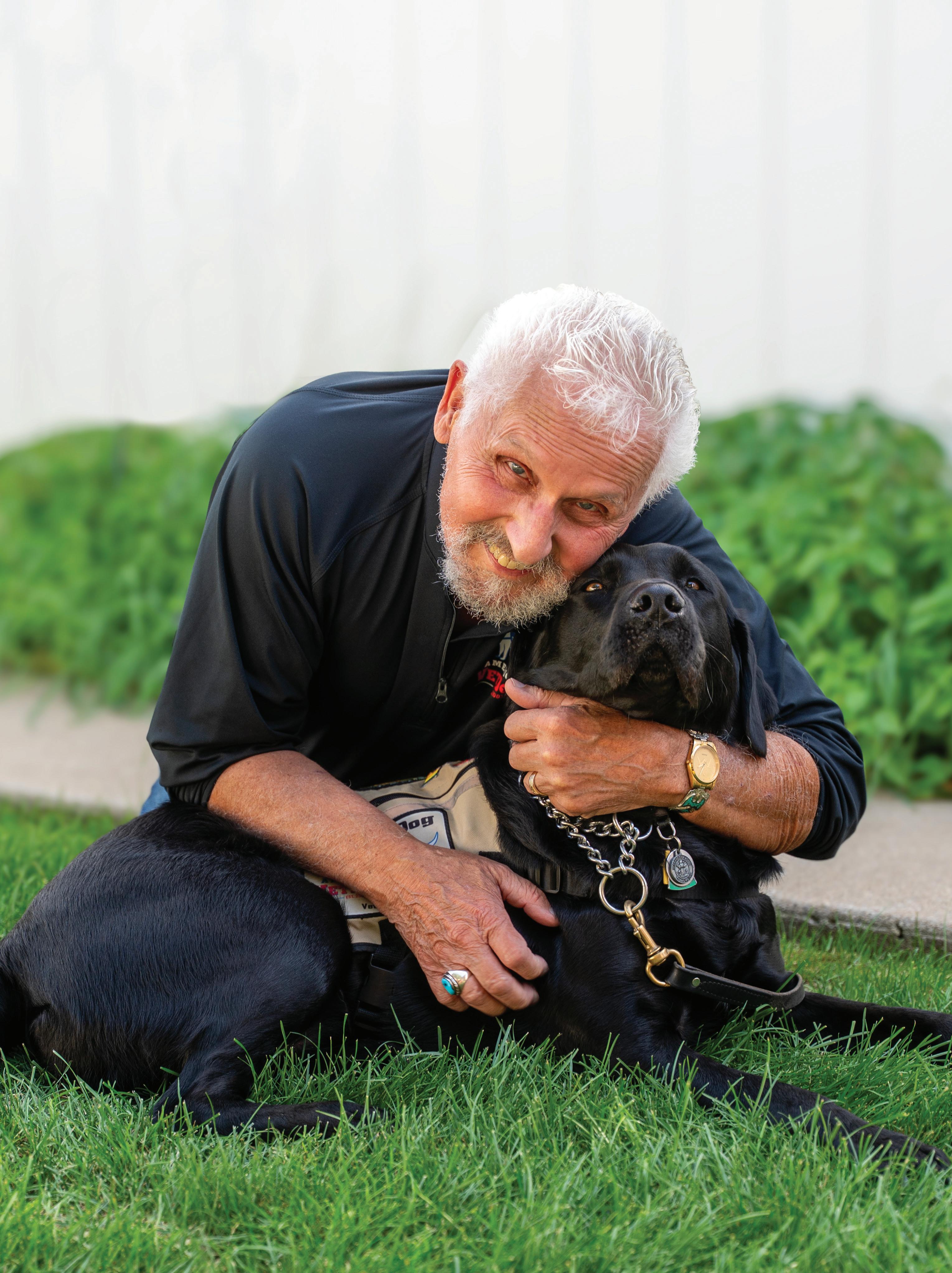
Tour Tour Tour
ARIZONA
JANUARY 2026
Ill. Walter F. Wheeler, 33°, Sovereign Grand Commander, along with members of the Supreme Council staff, will take to the skies for our annual Commander’s Tour, bringing updates, fellowship, and a vision for the future of the Scottish Rite.
FLORIDA
MARCH 2026
01 / 20 / 2026 | SUN CITY WEST
11:30 AM LUNCHEON • BRIARWOOD COUNTRY CLUB 20800 N 135th Avenue, Sun City West, AZ
03 / 24 / 2026 | THE VILLAGES
8:30 AM BREAKFAST • THE WATERFRONT INN 1105 Lake Shore Drive, The Villages, FL
03 / 27 / 2026 - SARASOTA
11:30 AM LUNCHEON • PALM AIRE COUNTRY CLUB 5601 Country Club Way, Sarasota, FL
03 / 28 / 2026 - BONITA SPRINGS
REGISTER TO ATTEND
Ready to reconnect?
Visit the websites below for full details and to reserve your spot. We can’t wait to see you!
SPACE IS LIMITED, SO REGISTER TODAY TO SAVE YOUR SEAT AT THE 2026 COMMANDER'S TOUR

11:30 AM LUNCHEON • SPANISH WELLS COUNTRY CLUB 9801 Treasure Cay Lane, Bonita Springs, FL
03 / 30 / 2026 - TAMPA
11:30 AM LUNCHEON • THE RUSTY PELICAN 2425 N Rocky Point Drive, Tampa, FL
NORTH PALM BEACH
11:30 AM LUNCHEON • NORTH PALM BEACH COUNTRY CLUB 951 U.S. Route 1, North Palm Beach, FL








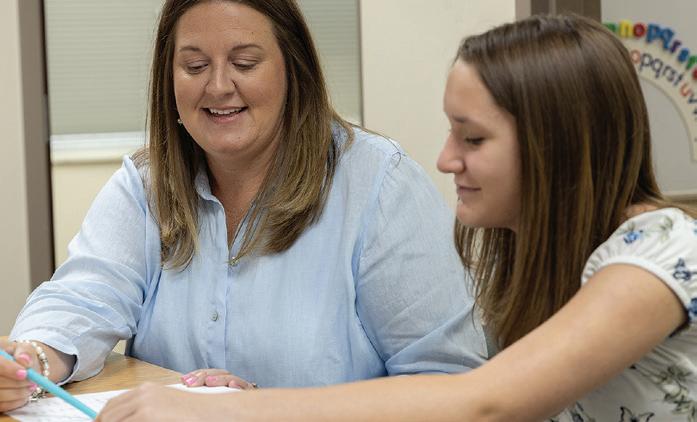


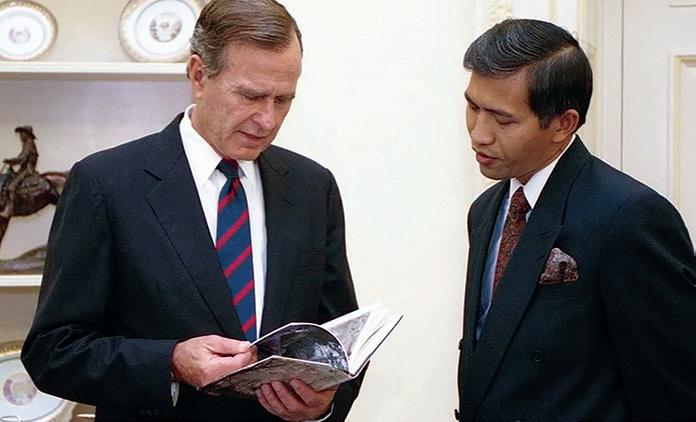
The Power of Showing Up
by Walter F. Wheeler, 33˚ Sovereign Grand Commander
When I reflect on what strengthens our Brotherhood, I am reminded that the most powerful thing we can do as Freemasons is often the simplest: Show up.
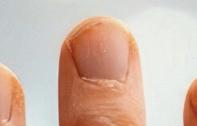

At our kickoff Listening Tour event in Lexington, I saw firsthand how meaningful this truth can be. My Scottish Rite Brothers gave up a large part of their Saturday to be there – not because they had to, but because they wanted to invest in the future of our Scottish Rite. They showed up, and because of that, the room was alive with energy, honesty, and hope.
During the breakout sessions, men shared openly about why they serve. Some were tasked with a leadership role
by an officer and discovered fulfillment along the way. Others spoke of wanting to leave their Valley better than they found it. A few shared stories of helping turn around struggling Valleys and the joy of seeing momentum return. None of that wisdom would have been possible without Brothers showing up and speaking from the heart.
I was struck by how often our conversations came back to presence. Leaders talked about what motivates them: fellowship, the degrees, the
chance to make a difference. None of those things exists in a vacuum. They require men to gather, to lend their voices, and to encourage one another. When Brothers showed up in Lexington, they made space for those conversations to unfold.
During the breakout sessions, men shared openly about why they serve.
The feedback we heard was practical and inspiring. Members called for more opportunities like Thursday Night at the Rite to be spread throughout the year. They praised the Passport Program as a driver of visitation and fellowship. They highlighted the life-changing impact of our Grand Almoner’s Fund and Children’s Dyslexia Centers, while challenging us to tell those stories more boldly.
The feedback we heard was practical and inspiring.
And beyond the formal agenda, I saw the quiet power of presence in the hallway conversations, the handshakes, and the laughter shared over coffee. One Brother said, “Just being here reminded me why I joined.” That is the power of showing up: it strengthens not only our Scottish Rite Fraternity, but also the individual Mason.
I know life is busy. Family, work, and obligations compete for our attention. But when you choose to show up – at your Valley, at your Blue Lodge, or simply at your Brother’s side – you
give something priceless. You give your presence. That gift can encourage, inspire, and heal more than you may ever know.
Our Scottish Rite has endured for more than two centuries not because of buildings or titles, but because men kept showing up for one another and for the Core Values that we hold dear.
But when you choose to show up – at your Valley, at your Blue Lodge, or simply at your Brother’s side – you give something priceless.
So, my challenge to you is simple: Keep showing up. Show up for your Brothers. Show up for your community. Show up for yourself. Because every time you do, you make us stronger.
We have officially wrapped up the Listening Tour, but there’s more in store at the Scottish Rite, NMJ. Save the date for this year’s Giving Tuesday event,
taking place on December 2, 2025, and we’ll see you there!
Journey On!

What’s in It for From Me?
I began my Masonic journey in 1997. On that November night, I was told by someone wise, “You get out of Masonry what you put into it.” What he said made sense to me then, and on some level, all these years later, it still does. Though I would readily admit that when I hear that said today, after having experienced so many facets of the Craft, it seems both inaccurate and inadequate.

Iget the meaning that it is supposed to convey: The more we put into it, the more we can expect to get out of it. That’s simple and it’s logical. If one does not practice his golf swing, his score on the course is not likely to improve. In the same way, if a new Mason gets his degrees and never again darkens the door of the lodge or Valley, he will be ill-equipped to strengthen his character or deepen the fraternal ties with his fellow Masons.
Let me explain, though, why I take some exception to it.
If you want to make a difference, you must start by making an effort.
First, I believe that it is inaccurate, in that what you put in (the thing), in no way resembles what you get out. You may spend dozens, even hundreds of hours over the course of several months learning your part in a degree that lasts only an hour. In return, you get the supreme honor of helping another on his quest to be the best man he can be. Likewise, when you donate to Scottish Rite charities, you give money. What
you get back is the pride in knowing that your contribution to the Grand Almoner’s Fund, White Flower Society, Children’s Dyslexia Centers, or any of our other charities fulfills our Masonic obligation of caring for our members. When a Mason gives his time, he may receive honor. If he gives money, he may receive a sense of pride. So what we get out is not exactly what we put in.
When a Mason gives his time, he may receive honor. If he gives money, he may receive a sense of pride.
Next, I believe that the saying is inadequate. I firmly believe that Masonry has given me far, far more than I could ever hope to give back. I never believed (and still have a hard time comprehending) that when the blindfold was lifted from my eyes, I would find myself in the presence of an ever-widening family – Brothers who would, with equal exuberance, celebrate my joys or help me in my darkest hours. They – you – would do so without question or hope of gain.
Likewise, the few hours spent mentoring a new member, learning a part, or helping a Brother in need are repaid with lifetime friendships. The bonds which I have forged because of Freemasonry are deep, they are authentic, and they are inexpressible. Did I get out what I put in? Not even close. Freemasonry has enriched me beyond my expectations.
by PJ Roup, 33˚, Editor, Active for Pennsylvania
We live in a culture that puts personal well-being ahead of the greater good. Volunteerism is low, and membership in religious groups and fraternal organizations has continued to decline. There are many who believe that they are indeed the “I” in “society” and, as its central letter, they should be worshipped and adored. They look at service and ask, “What’s in it for me?” As Freemasons, we must look at service and ask, “What’s in it from me?”
The bonds which I have forged because of Freemasonry are deep, they are authentic, and they are inexpressible.
Whether you are a brand-new Mason or a 50-year member, consider anew
the call to service. If you want to make a difference, you must start by making an effort. It doesn’t matter which lodge or Valley you call home; they need you. No lodge is so flush with volunteers, whether for the Officer Line, as an Ambassador, or even the pancake breakfast committee, that you will be turned away.
Masonry offers so much – opportunities to grow, to lead, to give back. Most importantly, it is a place where you can meet others on their journey, walk with them a while, and share the view. Freemasonry is the only place that can happen, and it is your place.
Will you get out of Freemasonry what you put into it? Absolutely not.
And isn’t that a beautiful thing?

THE NORTHERN LIGHT
A magazine of 32˚ Scottish Rite Freemasonry Fall 2025 | Vol. 56 | No.3
SOVEREIGN GRAND COMMANDER
Walter F. Wheeler, 33°
EXECUTIVE EDITOR
Linda R. Patch
EDITOR PJ Roup, 33°
CREATIVE DIRECTOR
Rodney E. Boyce, 33°
CONTENT MANAGER
Joann Williams-Hoxha
DIRECTOR OF DESIGN
Matt Blaisdell, 32°
COMMUNICATIONS COMMITTEE
Richard J. Powell, 33°, Chairman
Donald M. Moran, 33° PJ Roup, 33°
William E. Tienken, 33°
Howard D. Turner, 33°
SUPREME COUNCIL, 33°
Ancient Accepted Scottish Rite, Northern Masonic Jurisdiction, U.S.A.
THE NORTHERN LIGHT (ISSN 1088-4416) is published quarterly in the Spring, Summer, Fall, and Winter by the Supreme Council, 33°, Ancient Accepted Scottish Rite, Northern Masonic Jurisdiction, U.S.A., as the official publication. Printed in U.S.A. Periodicals postage paid at Boston, MA, and at additional mailing offices.
POSTMASTER Send address changes to The Northern Light PO Box 519, Lexington, MA 02420-0519
MAILING ADDRESS PO Box 519, Lexington, MA 02420-0519
EDITORIAL OFFICE
33 Marrett Road (Route 2A), Lexington, MA 02421 phone: 781-862-4410 email: editor@srnmj.org
WEBSITE: www.ScottishRiteNMJ.org
@TNLMagazine
Copyright ©2025 by Trustees of the Supreme Council of the Ancient Accepted Scottish Rite of Freemasonry for the Northern Masonic Jurisdiction, U.S.A.
Rite in the Fast Lane
It was pedal to the metal at this year’s Annual Meeting in August. More than 2,000 Masons and their guests took part in the festivities and enjoyed all that the city of Indianapolis has to offer.
At the second General Session on August 26, 222 Sublime Princes of the Royal Secret were coroneted Sovereign Grand Inspectors
General. Congratulations to the newest Honorary Members of the Supreme Council, NMJ!
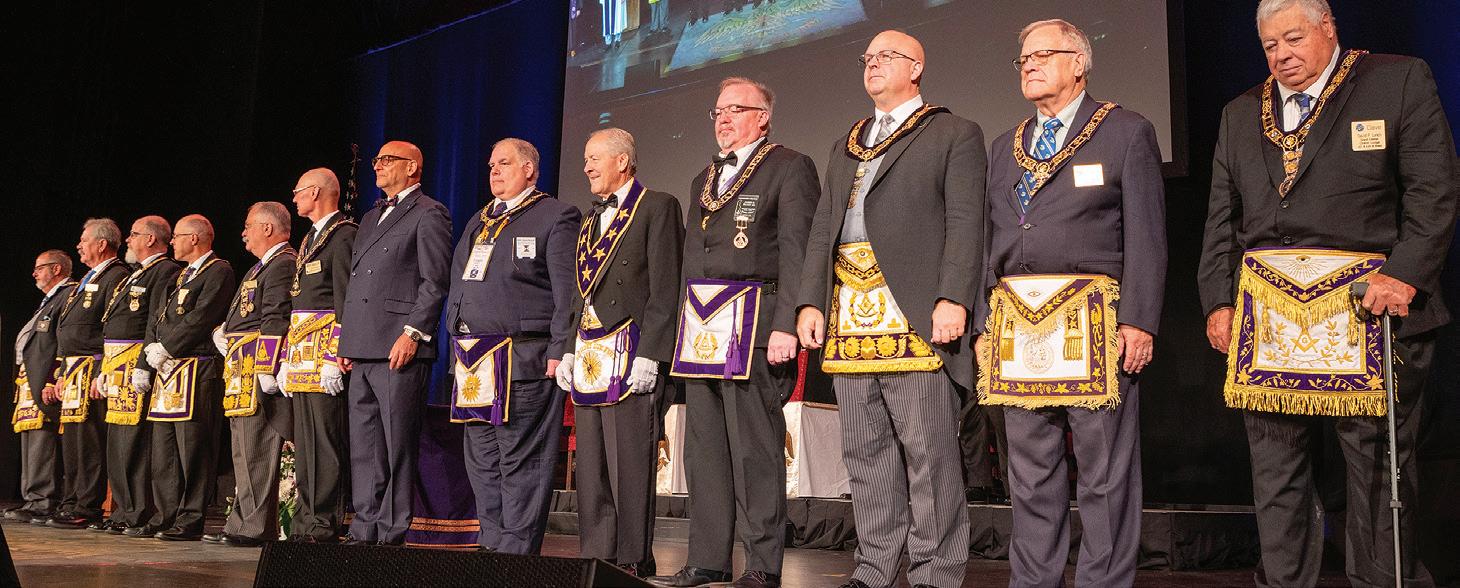
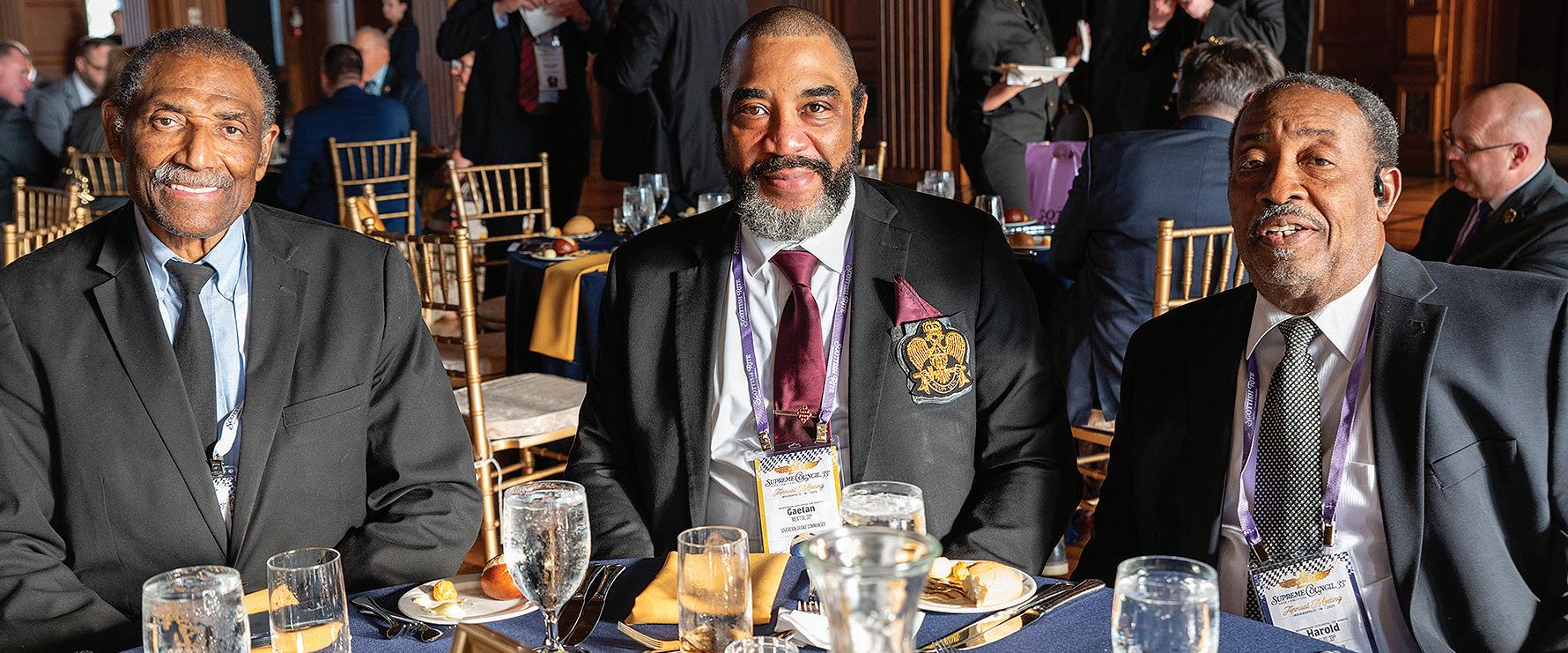


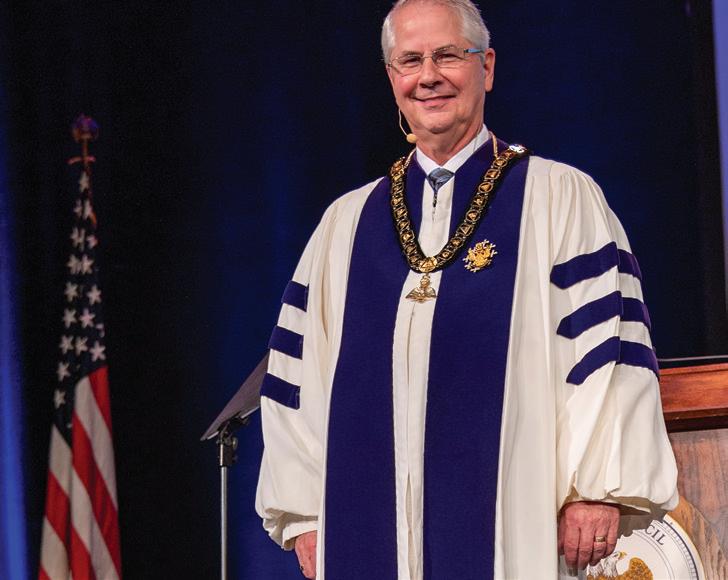


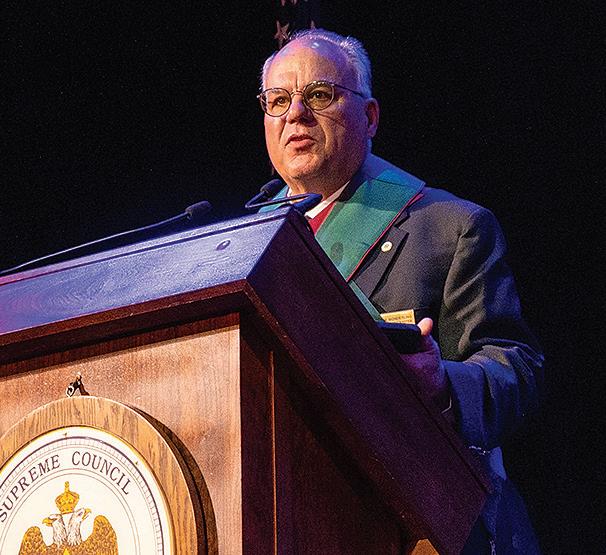




New State Deputies

RHODE ISLAND
Ill. Kenneth F. Poyton, 33°, became the new Deputy for Rhode Island.

ILLINOIS
Ill. Nick Graff, 33°, became the new Deputy for Illinois.
Deputy Changes

RHODE ISLAND
Ill. Steven E. Smith, 33°, retired as State Deputy for Rhode Island and remains as Grand Lieutenant Commander and Active Member.
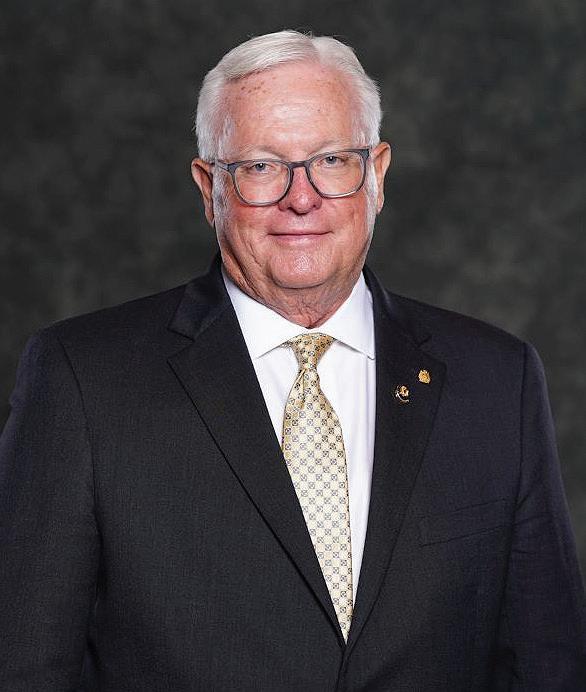
ILLINOIS
Ill. Gregory L. Clark, 33°, retired as State Deputy for Illinois and will become an Active Emeritus Member.
Active
Emeritus/Past Active Members New Active Members
In addition to Ill. Gregory L. Clark, 33°, the following Active Members became Active Emeritus or Past Active Members.

ILLINOIS
Ill. Anthony R. Cracco, 33°, Active Emertitus

VERMONT
Ill. Donald G. Duquette, 33°, Active Emertitus

OHIO
Ill. Philip R. Elliott Jr., 33°, Active Emertitus
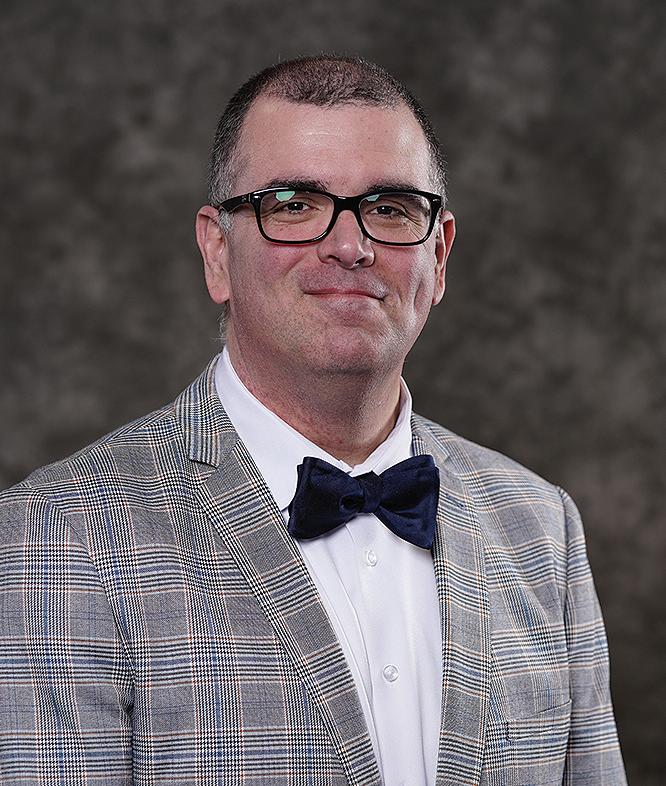
INIDIANA
Ill. John Brian McNaughton, 33°, Past Active
Supreme Council welcomed the following New Active Members.
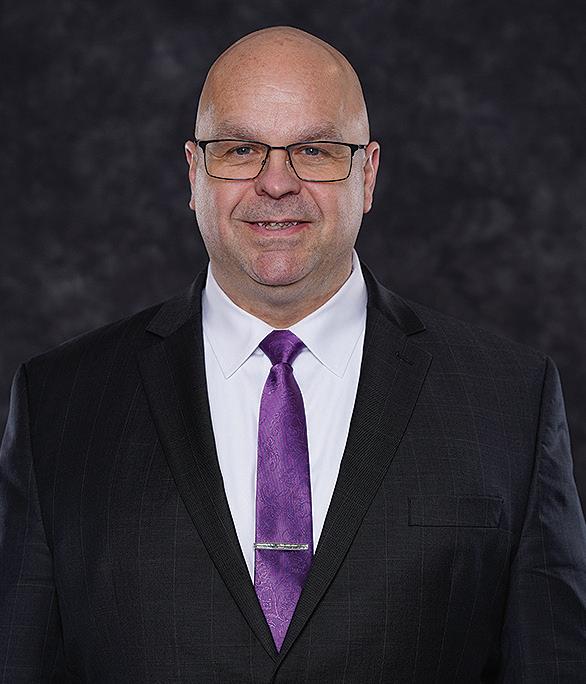
Ill. William M. Carter III, 33°

Ill. Daniel E. Bartlett, 33°
MAINE
OHIO

NEW YORK
Ill. Gary L. Burke, 33°, MSA
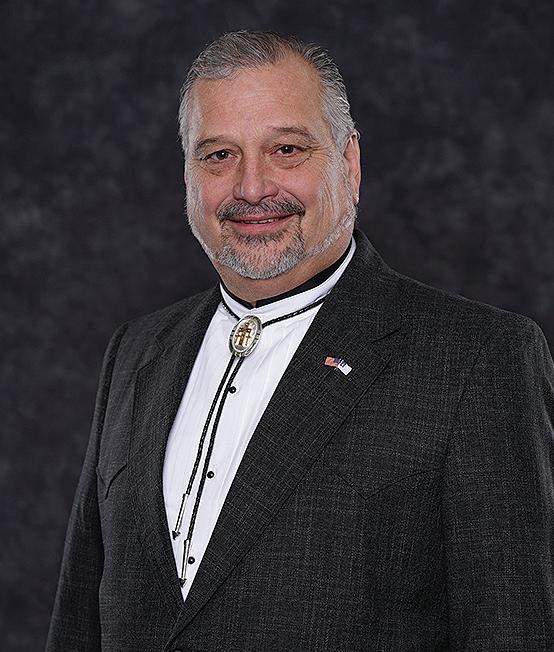
VERMONT
Ill. Robert O. Bach, 33°, MSA
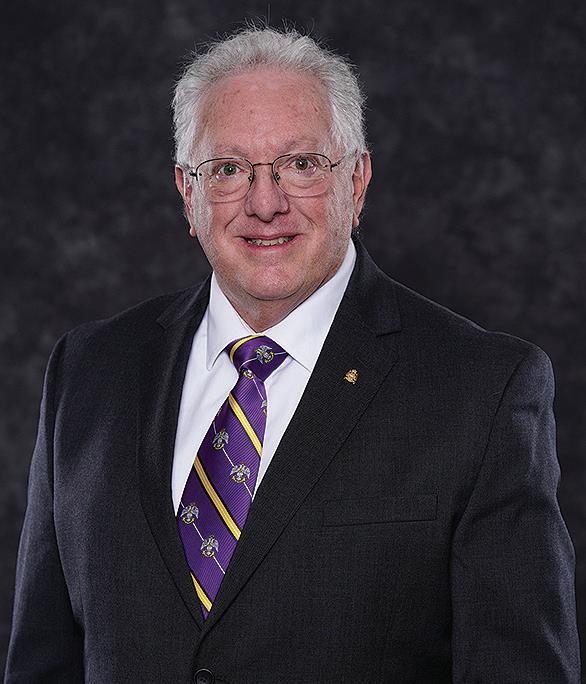
ILLINOIS
Ill. Robert T. Trefzger, 33°

ILLINOIS
Ill. William E. Tienken, 33°
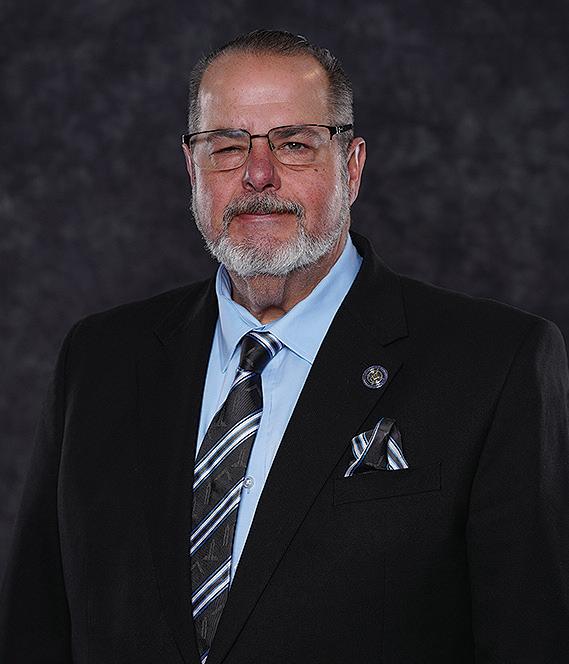
INDIANA
Ill. Randolph L. Seipel, 33°, MSA
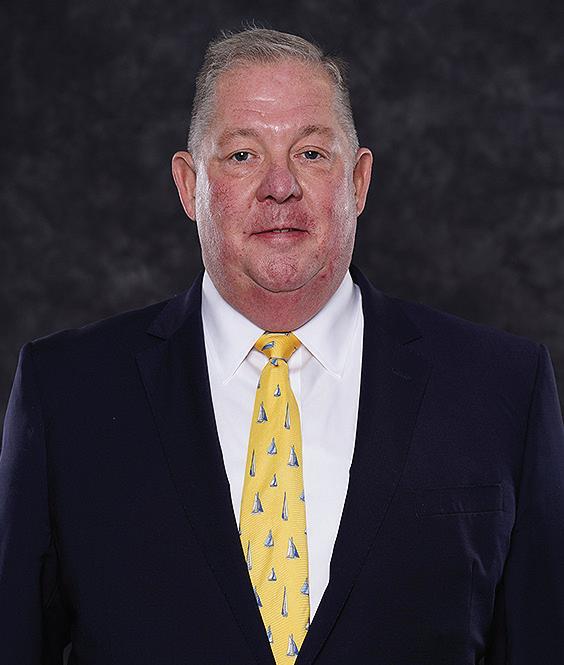
CONNECTICUT
Ill. Howard D. Turner, 33°, MSA
Medals, Awards, and Honors
At the General Session on August 25, Commander Wheeler presented the following medals:
D. Richard Heldman, 33°, Deputy for Ohio was awarded the Commander’s Medal for Distinguished Service. The Sovereign Grand Commander may, at his discretion, bestow his personal award upon a deserving Mason or Scottish Rite Brother whom he considers to have rendered outstanding, distinguished, and exemplary service to the Masonic Fraternity at large.
Douglas Kaylor, 33°, Active for Ohio, and James D. Cole, 33°, Sovereign Grand Commander of the Southern Jurisdiction, were presented with the Medal of Honor. The Medal of Honor may be conferred by the Supreme Council or by the Sovereign Grand Commander upon any person, whether or not a member of our jurisdiction or a member of any body of the Rite in recognition of distinguished service to Freemasonry, country, or humanity.
David Allan Bennett, 33°, Sovereign Grand Commander, Supreme Council, Canada, was made an Emeritus Member of Honor of this Supreme Council.

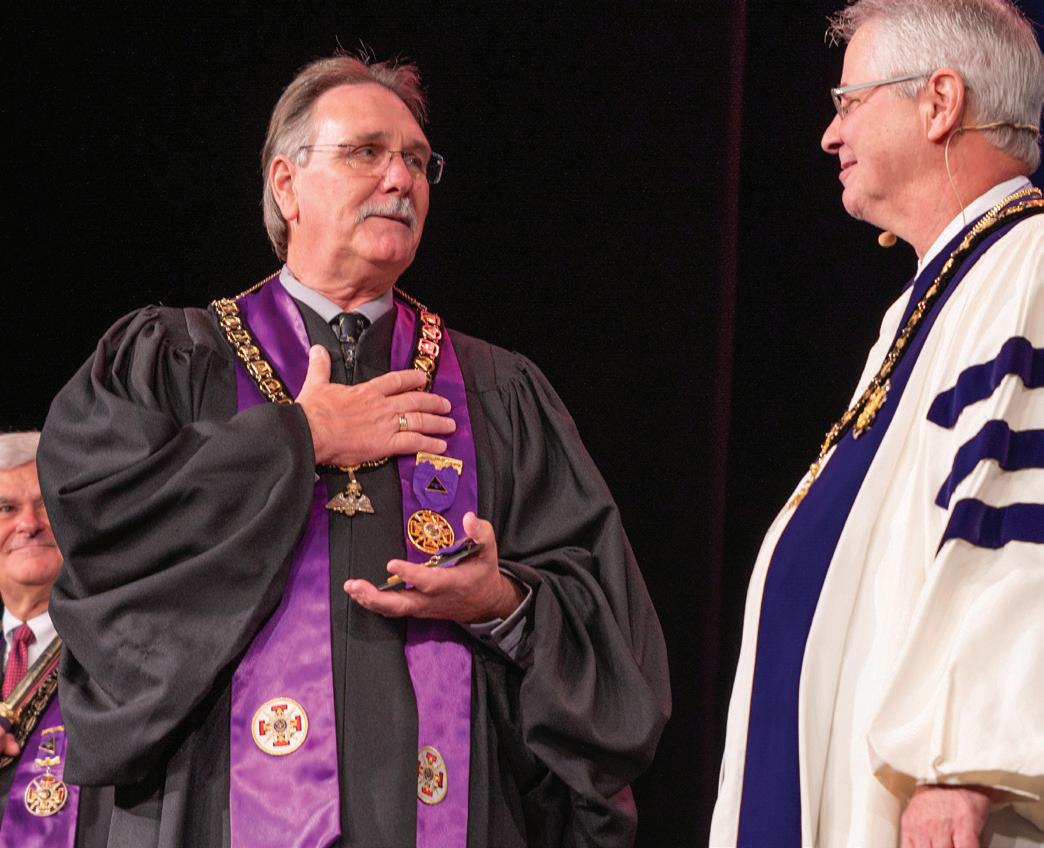



Douglas Kaylor, 33°
James D. Cole, 33°
David Allan Bennett, 33°
D. Richard Heldman, 33°
Commander Wheeler
Presented York Rite and Supreme Council, Southern Jurisdiction Honors
On August 9, Sovereign Grand Commander Walt Wheeler received The Order of the Purple Cross at the York Rite Sovereign College General Assembly in Raleigh, North Carolina.
The Order of the Purple Cross is the highest honor conferred by the York Rite Sovereign College of North America (YRSC), awarded to members who have demonstrated exceptional service to humanity, the York Rite, or Freemasonry in general.
At the Biennial Session of the Supreme Council of the Scottish Rite, Southern Jurisdiction on August 17, Commander Wheeler was elected an Emeritus Member of Honor of the Mother Council of the World. He was among 12 Illustrious Brethren who received this distinction.




Biennial Session of the Supreme Council of the Scottish Rite, Southern Jurisdiction
The Order of the Purple Cross
York Rite Sovereign College General Assembly in Raleigh, North Carolina
SCOTTISH RITE MASONIC MUSEUM & LIBRARY
Recent Acquisitions
Every year, the Scottish Rite Masonic Museum & Library seeks to broaden its collection in pursuit of our goal of exploring the history of Freemasonry, fraternalism, and the United States. In our effort to tell a rich and interesting story, the museum relies on gifts from individuals, families, and collectors, and makes judicious purchases of intriguing items. The objects here are all recent additions to the museum’s collection.
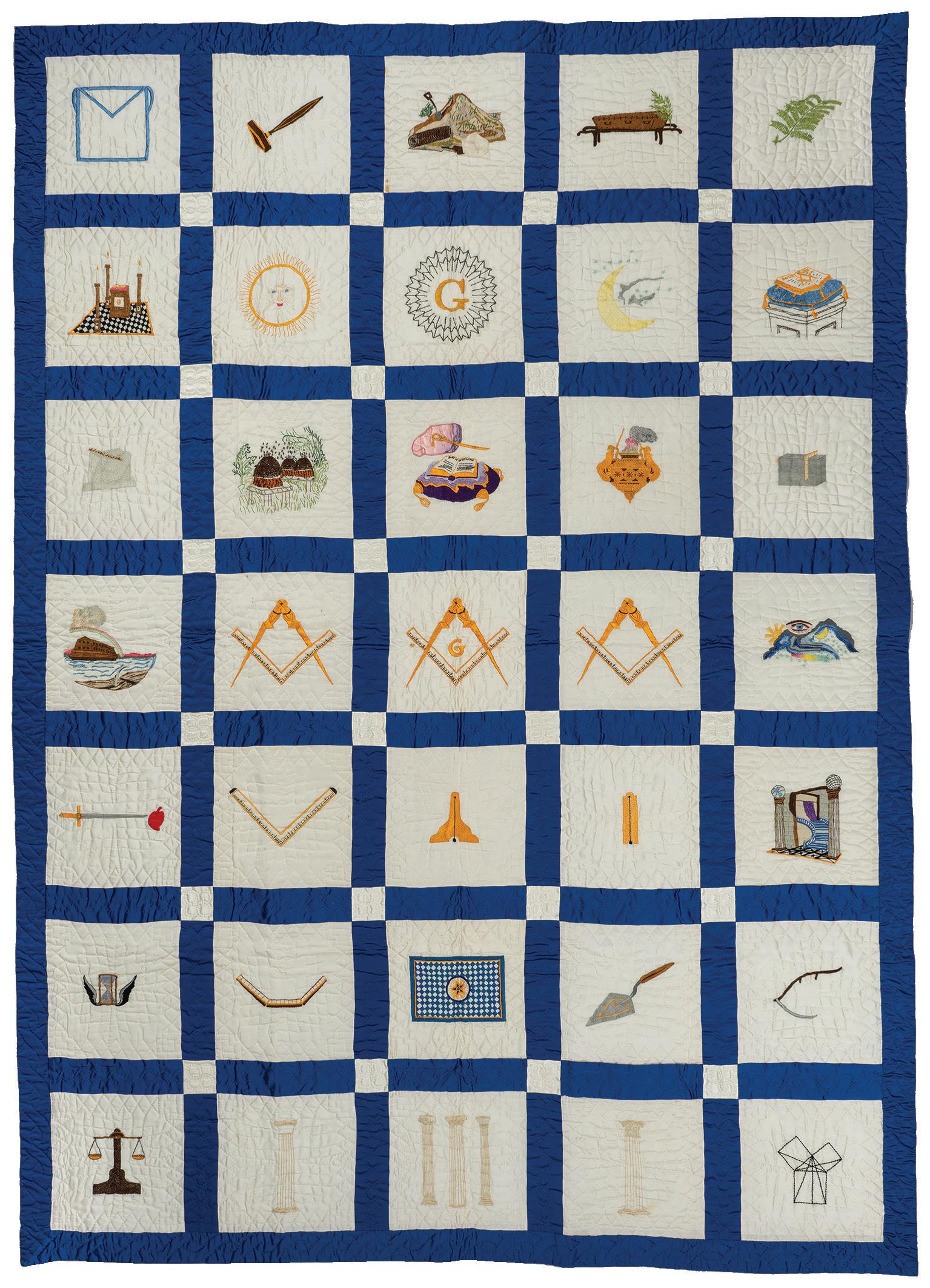
by Hilary Anderson Stelling, Director of Collections and Exhibitions, Scottish Rite Masonic Museum & Library
From 1971 through 1978, Regina LeFreniere Gordon (1915-2011) of Raymond, New Hampshire, designed, embroidered, and constructed this quilt. Each of the thirty-five squares on the quilt is embroidered in silk with a symbol or image related to the first three degrees of Freemasonry. Regina and her husband, Josiah, a Past Master of Tucker Lodge No. 99 in Raymond, New Hampshire, researched what images and symbols to feature on the quilt during their travels to different lodges in the U.S. and abroad.
From its beginnings, the Shrine has held annual meetings, known as Imperial Sessions, to discuss business, socialize, and stage friendly competitions. These meetings have fueled the creation of a charming variety of souvenirs. Often undertaken with a light spirit, these

Quilt, 1971-1978. Gift of John F. and Connie L. Gordon, 2022.032. Photograph by Michael Cardinali.
Glass, 1950. Gift of Francis Tharp, 2023.018.47. Photograph by Michael Cardinali.
souvenirs reflect the trends and fashions of their time, as well as the distinctive visual and material culture of the Shrine. These three Imperial Session keepsakes are part of a gift of over seventy examples of glass, ceramic, and metal items commemorating Masonic events and gatherings, recently given to the museum.
This pocket watch, one of a collection of several Masonic and fraternal presentation watches generously donated to the museum, bears the insignia of the fraternal group, the Improved Order of Red Men. George Jacob Yeager (1885-1942), a member of the order from Buffalo, New York, received this watch as a prize. He was the winner of a membership contest staged by Motacha Tribe No. 376 in 1914.
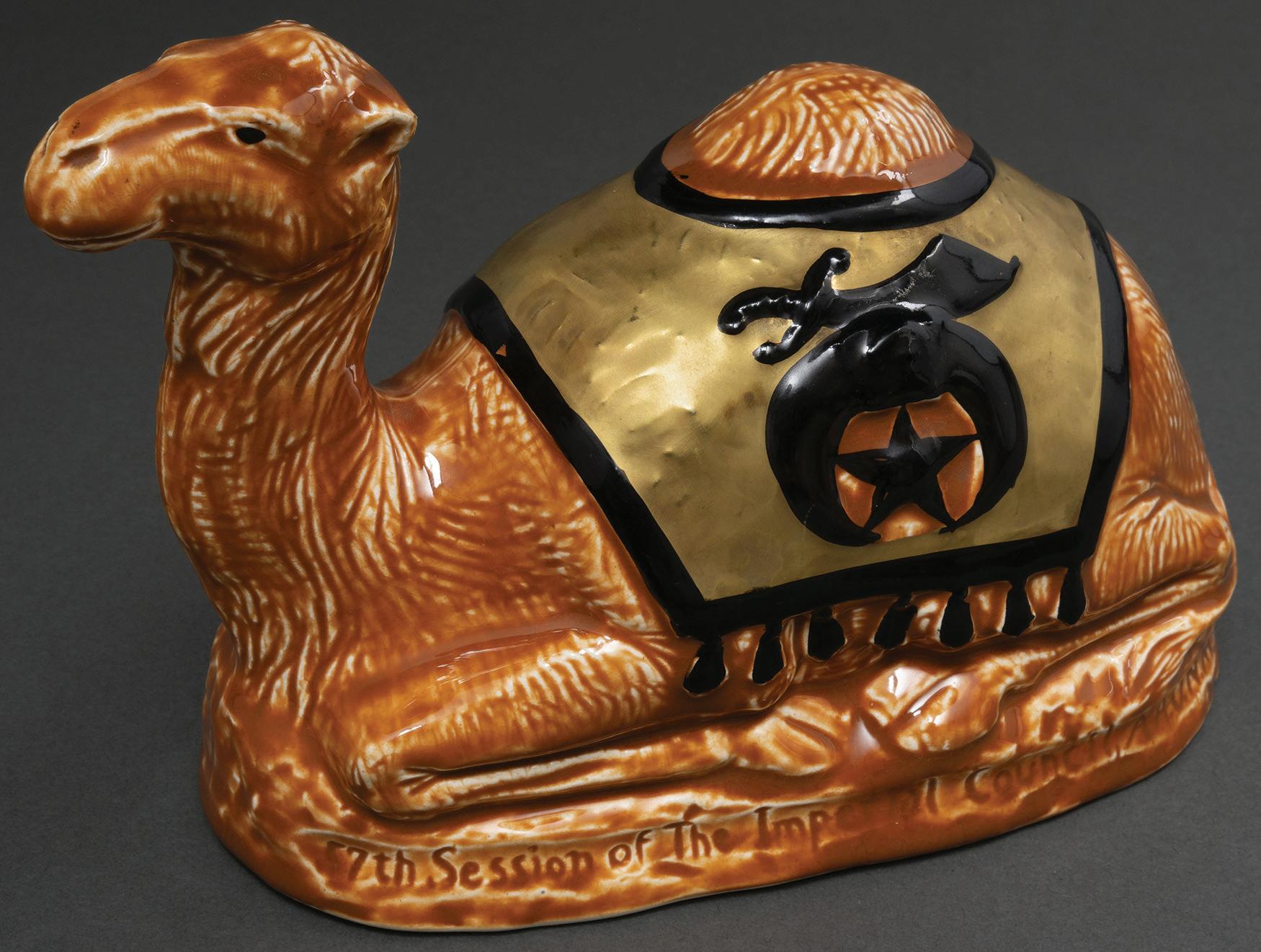

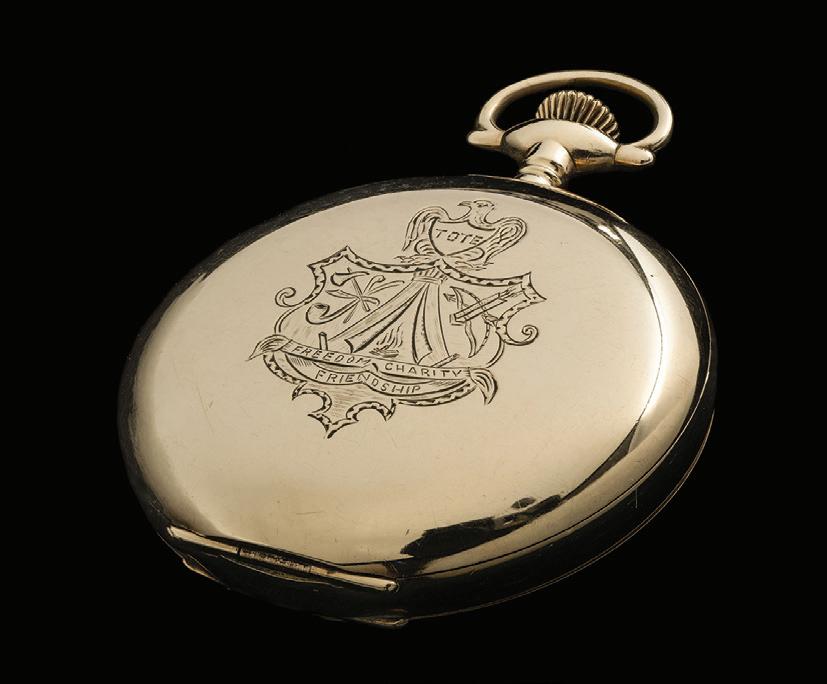

Souvenir, 1931. Gift of Francis Tharp, 2023.018.20. Photograph by Michael Cardinali.
Planter, 1911. Gift of Francis Tharp, 2023.018.65. Photograph by Michael Cardinali.
Watch, 1914. Gift of Eric Stott, 2023.024.2. Photograph by Michael Cardinali.
Detail, Watch, 1914. Gift of Eric Stott, 2023.024.2. Photograph by Michael Cardinali.
RECENT ACQUISITIONS
Members and advisors to Polaris Assembly 247 of the International Order of Rainbow for Girls in North Highlands, California, contributed embroidered and appliqued squares to form this album quilt. Made around 1977, some mottos and images on the signed quilt squares highlight symbols
used in Rainbow; others reference popular culture of the day, such as Snoopy, Holly Hobbie, and zodiac signs. This cheerful bedcovering was likely created as a thank-you or leavetaking present for someone associated with the assembly.
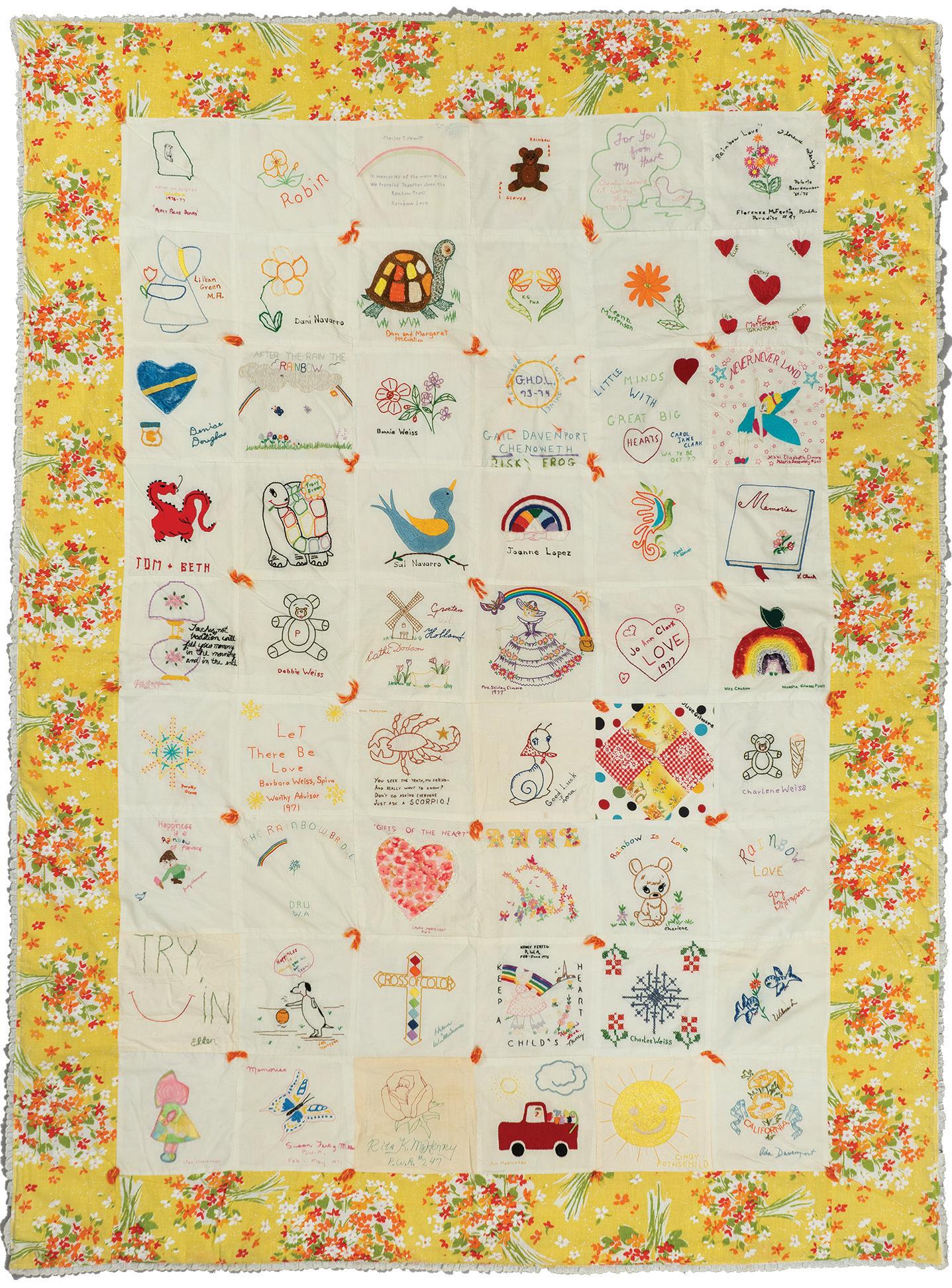
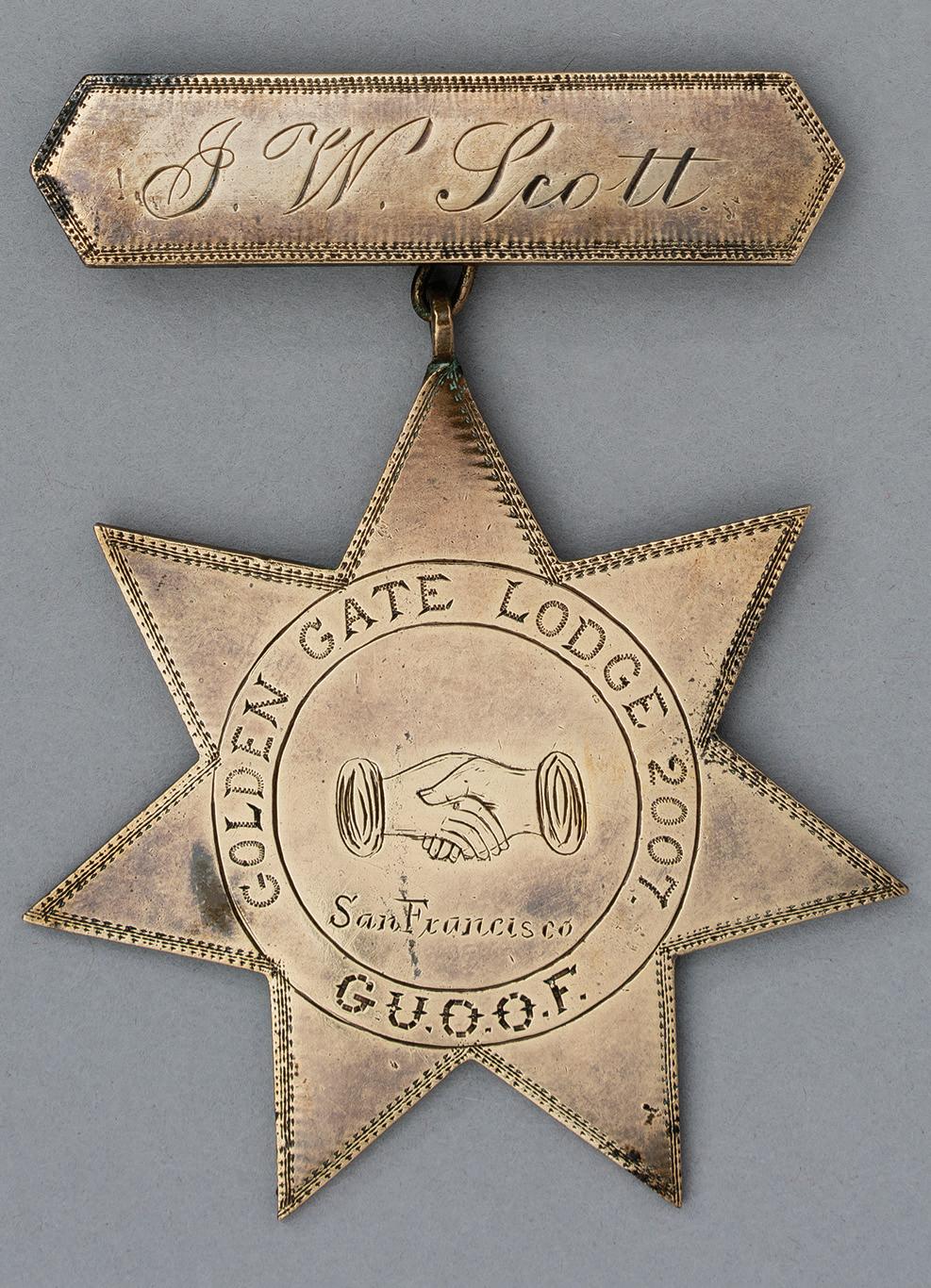
Excluded from American Odd Fellowship, a group of Black men sought a charter to form their own lodge from the Grand United Order of Odd Fellows, a branch of Odd Fellowship active in England. In 1843, these New York City-based founders established Philomathean Lodge No. 646. The GUOOF grew nationwide. In 1880, GUOOF members in San Francisco started Golden Gate Lodge No. 2007. The lodge’s membership numbered 200 by its first anniversary. This jewel belonged to J. W. Scott, a member of the lodge.
James Vila Dexter (1836-1899) made a fortune in mining, banking, and hotels in Colorado. Dexter moved from Illinois to Colorado in the late 1860s,
Jewel Owned by J. W. Scott, Golden Gate Lodge No. 2007, ca. 1895. Museum Purchase, 2024.028. Photograph by Michael Cardinali.
Quilt, ca. 1977. Museum Purchase, 2021.020. Photograph by Michael Cardinali.

attracted by the possibilities of mining. Along with his entrepreneurial pursuits, Dexter was an active Freemason. Dexter helped charter a new lodge in Fairplay, Colorado, and was involved in the York and Scottish Rites. This ring, decorated in white and black enamel on a textured background, speaks to Dexter’s long association with Freemasonry and the metal that drew him to the Colorado Territory.
In 1867, Dr. Albert Gallatin Mackey (1807-1881) addressed his Brethren
at a meeting of the Grand Chapter of South Carolina. Mackey reviewed his long association with the group, starting from 1847, when the state claimed only two functioning chapters. By 1860, Mackey had helped establish 22 chapters. Seven years later, Mackey removed his name from consideration as Grand High Priest, citing the “imperative and unexpected calls of public business.” To acknowledge Mackey’s many contributions to Royal Arch Freemasonry in the state, the Grand Chapter presented this jewel to him in 1875.
Developed in France in the late 1830s, daguerreotype technology allowed artists to capture photographic images on silver-coated plates. This innovation soon made its way to the United States. By 1850, hundreds of daguerreotypists had established studios in towns and cities across the nation. In Ohio, where
Thinking about donating an object to the Scottish Rite Masonic Museum & Library? Please contact us at info@srmml.org. ?


this image is thought to have been taken, artists advertised daguerreotypes for an affordable $1.00 to $1.50 in the early 1850s. The subject of this striking portrait wears the regalia of the Encampment, a body that offered higher degrees for Odd Fellows.
Past Most Excellent Grand High Priest Jewel Made for A. G. Mackey, 1875. Gift of the Estate of John F. Bemis and Randall E. Bemis, 2024.011.64. Photograph by Michael Cardinali.
Ring, ca. 1881. Gift of Elinor Benton Ives, 2023.022. Photograph by Michael Cardinali.
Portrait of an Odd Fellow, 1850-1860. Museum Purchase, 2024.034.1. Photograph by Michael Cardinali.
“EXPEL HIM AND EXPEL HIM QUICKLY”:
A Union Response to a Brother Joining the Confederate Army
In the 1863 Proceedings of the Grand Lodge of Indiana, the “Address” by Grand Master John B. Fravel (1814-1876) looked at the question of whether a Mason who left the Union to join the Confederate Army should automatically be expelled from Freemasonry. His opinion on the matter appears below the heading “Decision as to the Expulsion of a Disloyal Mason” and is focused on an actual case. The Grand Master considered:
On the 12th of July, 1862, the Worshipful Master of Allensville Lodge, No. 81 submitted to me the following question:
“A Brother in good standing in this Lodge has gone South, joined the Confederate Army, received a commission therein, and is now in arms against the Government of the United States. Can the Lodge expel him?”
My answer was that for that act alone, he could not be expelled. This decision is founded upon the express declarations set forth in the Second Chapter of the Ancient Charges…
Fravel then goes on to quote the passage in the Charges, and ends by saying, “This question possesses much interest to us at this particular time; and as such I esteem it to be my duty to lay the whole matter before the Grand Lodge, not that I apprehend in the
least that they will reverse the decision made, but that the Craft may know the precise position which we, as Masons, occupy to the legally constituted Government.”
Despite Fravel’s belief that no one in the Grand Lodge would reverse his decision, there was, in fact, a strongly worded response to Fravel in the “Reports from the Committee on Masonic Jurisprudence,” which contained a section entitled, “On Expulsion of Disloyal Brethren.” After a polite introduction in which the Committee states that the matter was referred to them by the Grand Master and that while he “quoted the law as anciently recognized correctly,” they did not believe that “in the decision, as reported by the M.W. Grand Master, the law is correctly applied.” The report goes on to ask that if Canada or Mexico “should call together a large army, and with munitions of war advancing towards our borders, threatening to burn and destroy our cities, lay waste to our country and rob and murder our citizens,” whether the Grand Master would rule the same way as he did with regard to the Confederacy.
The report ends with little question as to what the Committee on Masonic Jurisprudence thought should be done with a Mason who left the Union and joined the Confederate Army. The heat of the language makes clear how strongly passions burned on this topic in 1863:
by Jeffrey Croteau, Director of Library & Archives, Scottish Rite Masonic Museum & Library
Expel him and expel him quickly; and should you ever catch him engaged in his unholy purposes, treat him just as you would the assassin who, in the dead hour of night, would, with stealth, enter your bed-chamber, and there, while carrying out his purposes of robbery, plunge the dagger to the heart of the wife reposing on your bosom.
Your Committee deny, in the most emphatic terms, that there is any law of Masonry contravening or setting aside the first law of nature, ‘Self-Preservation.’
As can be seen from the example above, even as Masons held meetings during the Civil War, the conflict was never far from their minds. Due to the era that these Freemasons lived in, they were sometimes called upon to address –and answer – questions unique to their time.
Have you read the Museum’s blog?
Back in 2008, the Scottish Rite Masonic Museum & Library (SRMML) launched its blog, providing an online venue to share stories behind the many interesting objects in its collection. This article is just one example of the wide variety of objects and topics covered in the blog. Curious to learn more? You can find hundreds of articles about the museum’s collections at https://www.srmml.org/blog/. ?

Portrait of John B. Fravel
A History of Freemasonry in Indiana from 1806 to 1898. Indianapolis: Grand Lodge of Indiana, 1898. Scottish Rite Masonic Museum & Library, 17.9755 .M167 1898.

A Source of

HAUTS GRADES ACADEMY

Scottish Rite degrees in the Northern Masonic Jurisdiction may be viewed (in person or via Thursday Night at the Rite) or read. Brethren participating in the Hauts Grades Academy program have the option of doing both and engaging in meaningful reflection on the lessons taught in our Rite.
The dramas and allegories, in many respects, are a form of fiction. Watching or reading fiction can enhance critical thinking, theory of mind, social elements such as empathy, and how those factors relate to the Scottish Rite Core Values. My experiences as a level two reviewer of essays in the HGA program have shown me that participants are learning and growing in knowledge and understanding with each review they write.
The Hauts Grades Academy program has three levels:
• Level One – reviewing the ritual of all 29 Scottish Rite, NMJ degrees.
• Level Two – The essay portion of the curriculum, which allows for self-reflection and review of nine Scottish Rite degrees selected by the candidate.
• Level Three – A written research paper.
In my 2018 Level Three research paper, I explored in detail the way Core Values and the process of deliberate and careful reflection can enhance a member’s learning and affinity with the Rite. By signing into the Member Center, members may read the full paper (and the papers of all HGA graduates) by accessing the list of HGA Scholars.
All Scottish Rite Brethren can use reflection to increase learning from Scottish Rite degrees.
Our Scottish Rite Core Values include Integrity, Service to Humanity, Reverence for God, Devotion to Country, Justice, and Tolerance. When developing Level Two essays, HGA Scholar candidates are to explain why they chose to write on a particular degree, how it impacted them, if the Core Values and lessons of the degree were communicated clearly, and how
by Michael Moran, 33°, HGA Valley of Harrisburg

To learn more about HGA and sign up for the waitlist, visit ScottishRiteNMJ.org/ hauts-grades-academy !

they will use those lessons inside and outside of Freemasonry.
While some degrees are based on a factual story, all of them are works of fiction, with situations and dialogue coming from the imagination of one or more authors. Reading and watching fiction is a helpful way to develop critical thinking, empathy, and the ability to recognize another person’s mental and emotional states. Participating in theatre and our degree work is associated with improved empathic abilities, social interactions, interpersonal communications, and tolerance.
Considering the Scottish Rite Core Values improves cognitive skills. Critical thinking and social communication can be developed through all the Core Values. Theory of mind is enhanced through Integrity, Justice, and Tolerance. Empathy grows when members focus on Integrity, Service to Humanity, Justice, and Tolerance. Social interactions naturally grow through Service, Reverence for God, Devotion to Country, and Justice.
When reviewing essays, I use tools such as Bloom’s and Fink’s Taxonomies to assess the learning demonstrated in the papers. For instance, papers tend to include various levels of thinking, such as understanding and analysis (Bloom’s Taxonomy). As Brethren apply the degree information to their personal journey, the essays often reflect the highest level of thinking, known as creating.
Fink’s Taxonomy (of significant learning) is another useful tool for assessing the essays. Two components of the taxonomy are usually demonstrated: integration (identifying relationships) and caring (caring more deeply about subjects and issues).
While providing feedback, I point out those positive elements of the essays. Importantly, I have found that a Brother’s academic background is not necessarily related to the quality of the essay. Many Brethren, regardless of their level of education, have submitted meaningful, thoughtful work.
Other Forms of Self-Reflection
All Scottish Rite Brethren can use reflection to increase learning from Scottish Rite degrees. For instance, at the Valley of Harrisburg, postdrama reflection discussions occur following some of the degrees at each Reunion. Those discussions are led by a facilitator, using prepared questions and statements to encourage audience involvement. Those items were developed using Bloom’s Taxonomy to encourage a range of thinking
levels. Fink’s Taxonomy has revealed consistent significant learning over the course of several reunions. Analysis has been positive, and Brethren have requested additional discussions.
Reading and watching fiction is a helpful way to develop critical thinking, empathy, and the ability to recognize another person’s mental and emotional states.
The NMJ website accurately states, “The Scottish Rite is often referred to as the “University of Freemasonry” because our degrees help men journey deeper into their Masonic education. Through examination of different philosophies, religions, and ethics, the degrees help Scottish Rite Masons reflect on their lives and find their own answers to universal questions.”
Reviewing essays has given me the opportunity to gain perspective and appreciate various points of view. There have been frames of reference I hadn’t considered before. The opinions and critical thinking within the essays have been a benefit to my own Masonic journey. This is further evidence that growth is possible for all members – novice and experienced – when engaging in meaningful reflection on the degrees.
Michael Moran
SEARCHING FOR THAT WHICH IS LOST
Cryptic puzzles are a popular feature in the Scottish Rite Journal. Below are select topics covered in recent Masonic-themed challenges in the Journal, some referencing Ill. Albert Pike’s seminal Scottish Rite classic Morals and Dogma (M&D). Prepare yourself to enter the word search crypt and find that which has been lost!
—Mark Dreisonstok, 33°, Managing Editor, Scottish Rite Journal
Word search and watercolor of the former Crypt Room at the George Washington Masonic National Memorial in Alexandria, Va., by Cordelia Dreisonstok
Greek Mythology in M&D
Hera
Hercules
Zeus
Masonic Composers
Ellington
Mozart
Sousa
Masonic Painters
Cole
Rockwell
Wood
Masonic Youth Groups
DeMolay
Job’s Daughters
Rainbow Girls
Roman Writers in M&D
Ovid
Seneca
Virgil
Tales from the Masonic Crypt
Agate
Nine Arches
Vault of Enoch
Wisdom of India in M&D
Jainism
Upanishads
Vedas

Want to read more of the Journal? Find it online at https://scottishrite.org, under the Education & Media tab.

Beyond the Quarry: Labors of Love
Thunder After the
by PJ Roup, 33˚, Editor, Active for Pennsylvania
After the thunder comes the rain. We are all probably familiar with that pithy aphorism – one that implies that following a period of strife, uncertainty, or turmoil, one can expect times of peace, calm, and predictability. We’ve probably all experienced it at some level – perhaps a new job after a period of unemployment, a clean bill of health after a medical struggle, or the resolution of a personal conflict. That saying, though, has a more literal meaning for Frank Lasick. You see, when he received his service dog, aptly named Thunder, his life changed for good.
BrotherFrank Lasick, 33°, Past Sovereign Prince from the Valley of Chicago, enlisted in the Marine Corps in 1968, just before high school graduation on a 120-day delay program. “I didn’t
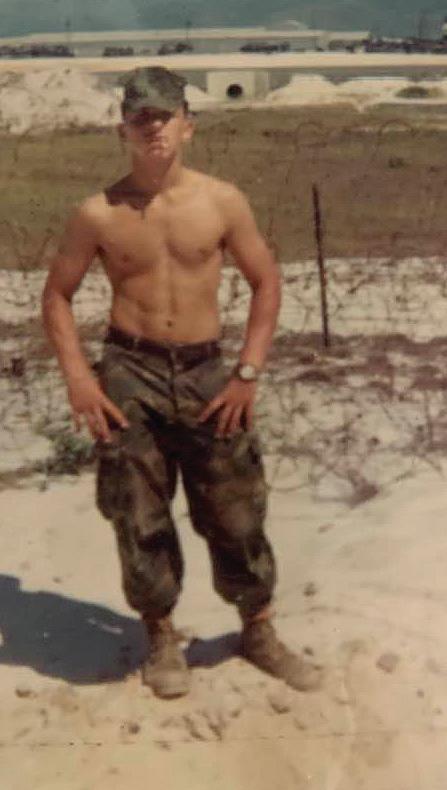


tell anybody because I didn’t want them to know,” he said. He singled himself out in boot camp as an expert marksman. They offered him a chance to get into the sniper program, but he declined, instead choosing to go to Parris Island to train fellow Marines to shoot. He enjoyed his time there, but something nagged at him. He transferred to Charleston, South Carolina, and served as an MP for a while, but that still wasn’t enough. “I wanted to be a veteran,” he recalled.
He had already lost some friends over there, and he wanted to serve his country.
He put in for a transfer. His sergeant told him he could go to Vietnam, Guantanamo Bay, or Finland. “I told him I’d take one for Vietnam,” Frank said. “He came from behind his chair and hugged me.”
When the sergeant asked him why he wanted to go to Vietnam, Frank’s reply was simple. He had already lost some friends over there, and he wanted to serve his country.

Frank served honorably, and like so many Vietnam veterans, he came back a changed man.
“[My time there] affected me a lot. Doing the operations and going out on patrol…you never know. I was always scared because when we would go out at the north end of the airstrip, the morgue was there. You’d look to the right and see all these coffins stacked. And then you’d say, ‘Am I going to be in one of those when I come back?’”
Frank had gotten engaged before leaving for Vietnam but called it off for her sake when he came back. “Look,” he told her, “I’m not the kid I was in high school anymore. I’m different.”
Frank spent years struggling with PTSD. From the early 1980s on, he, like so many, tried pushing the pain
Frank in Da Nang
Frank in Vietnam
down, dealing with it silently. He even tried therapy at the VA, but nothing seemed to work. He briefly considered a service animal, but the programs in Illinois weren’t right for him. “I wasn’t going to raise a puppy from scratch,” he said. His wife, Patricia, pleaded with him to get some help for the sake of their marriage.
Finally, during COVID, a friend recommended a therapy group of about 30 veterans. Initially, it seemed to help. “I had never sat with a group,” he said. “And it was making me think different.” The good results, however, were short-lived.

Frank had reached the end of his rope. He was tired of the pain. He found himself in the basement with a gun in his hand. “I decided that I don’t want to live. I can’t handle this. You want to cry, but you can’t cry. And once you do, you can’t stop.”
“I told her my story. She was with me, giving me confidence.”
He was looking at pictures of his family – his wife and kids – one last moment to hold onto the happy memories. “I think the memories are what stopped me.” One of the pictures
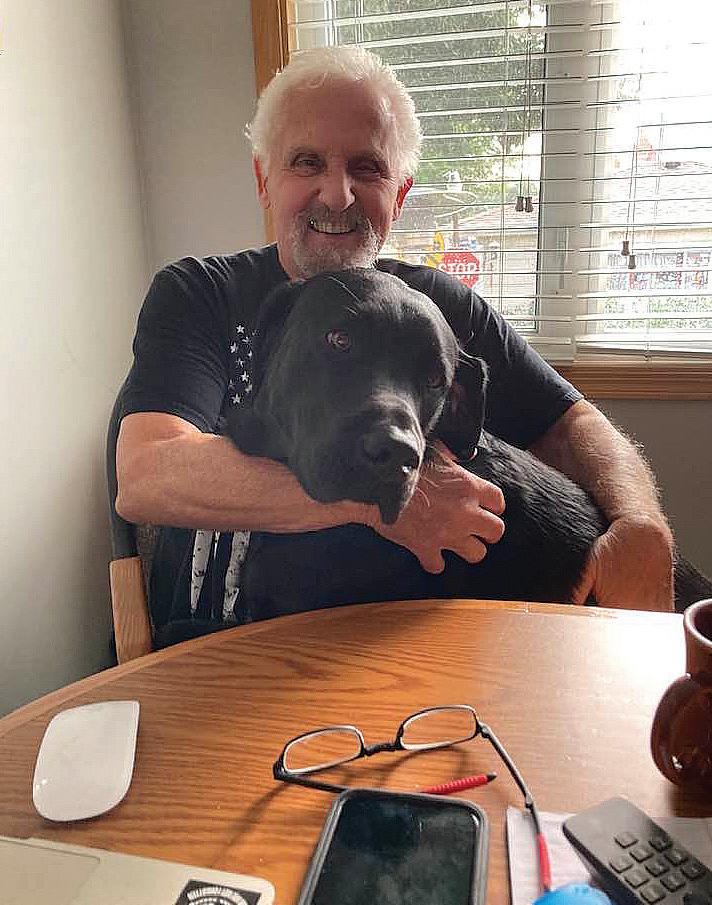
showed Frank and Patricia on a boat with their little Pekingese dogs. Seeing that picture, Frank’s thoughts again returned to getting a service dog. He put the gun down and went to the computer sitting right next to him.
“God was there with me. I guarantee you,” Frank recalled. “Why would he make me look at those pictures and then go right to the computer?” His search led him to America’s VetDogs. That decision quite literally saved his life.
Frank filled out the online questionnaire and waited. A few months later, he got a call from Carolyn Giambalvo, an admissions assistant at America’s VetDogs. He hadn’t filled out the application correctly, but she helped him navigate the process and get into the program. Frank credits Carolyn with changing his life. “I told her my story. She was with me, giving me confidence.”
He was tired of the pain. He found himself in the basement with a gun in his hand.
America’s VetDogs was founded in 2013 by the Guide Dog Foundation for the Blind. Carolyn received her first dog from them in 2003. “I loved the organization so much, I started volunteering,” she said. “In 2008, I was lucky enough to become part of the consumer services office as an employee.”
Even though he had been accepted, the work was just beginning. Frank
Frank and Thunder at home
Beyond the Quarry: Labors of Love
Do you have an interesting hobby, event, or recreational activity that you would like to share with us? If so, contact editor@srnmj.org and let us know about it. You just might find yourself featured in a coming issue.
had to take videos of his home, his routine. They wanted to see his surroundings, assess his mobility, and ensure he could care for
“He’s my partner,” says Frank with a smile. “I owe him my life.”
call that he was matched. “I was so




excited I was crying because I thought this was going to help me.”
America’s VetDogs flew him to Smithtown, Long Island, where he met Thunder for the first time for a two-week intensive training course. It was love at first sight for both of them. Thunder is Frank’s service partner in the parlance of the organization, and he never leaves Frank’s side. “He can sense when I’m getting sad or aggravated, and he’ll come up and nudge me.” Thunder sleeps right next to the bed, and if he senses anything wrong, he’ll spring into action. If Frank is having a nightmare, Thunder wakes him. If he’s restless, Thunder lies next to him to calm him. He has become an indispensable part of the family.
Since receiving Thunder, Frank has become an unflinching advocate for
Thunder
the organization. “He’s done speaking engagements for us,” Carolyn said. “Word of mouth is a big, big part of how people find out about us.”
More than anything, Frank is grateful for the days after the Thunder.
And they want people to find out about them. Their work saves lives, and Frank knows firsthand just how true that is. “A picture is worth a thousand words,” Carolyn said. “Just the fact that people are seeing one of our graduates and how the dogs are helping is an advertisement in and of itself. Because we’re a non-profit, we rely on the generosity of private donations.”
Frank and Thunder have no plans of stopping. Whenever he can, he
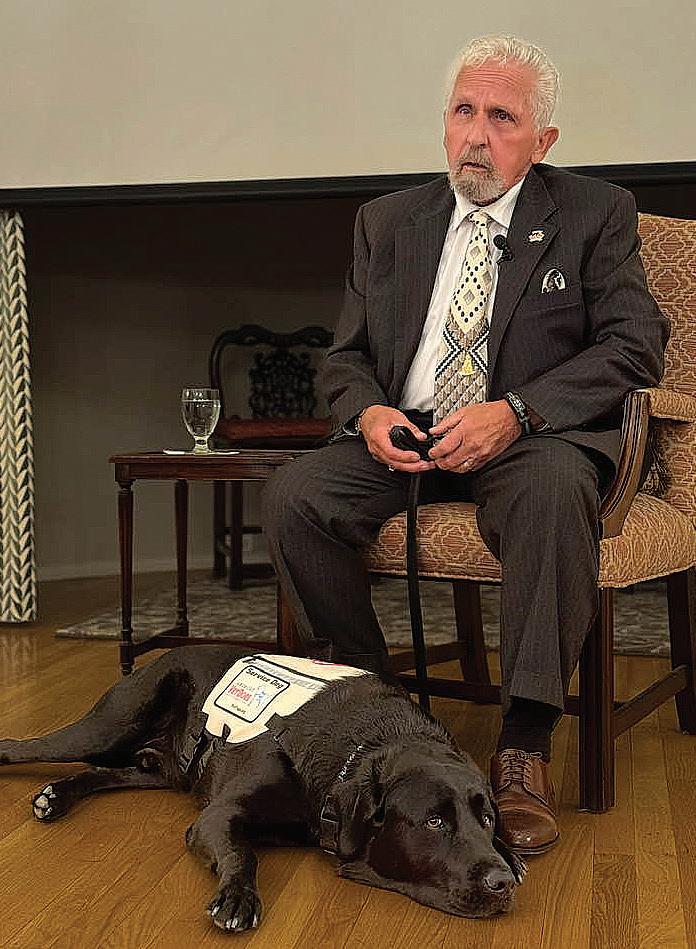
and Thunder attend events to raise awareness and funds so that other veterans can receive the same lifechanging help he did.
Recalling how his life was before Thunder, he observed that Thunder is

more than a pet, more than a friend. “He’s my partner,” says Frank with a smile. “I owe him my life.”
More than anything, Frank is grateful for the days after the Thunder.
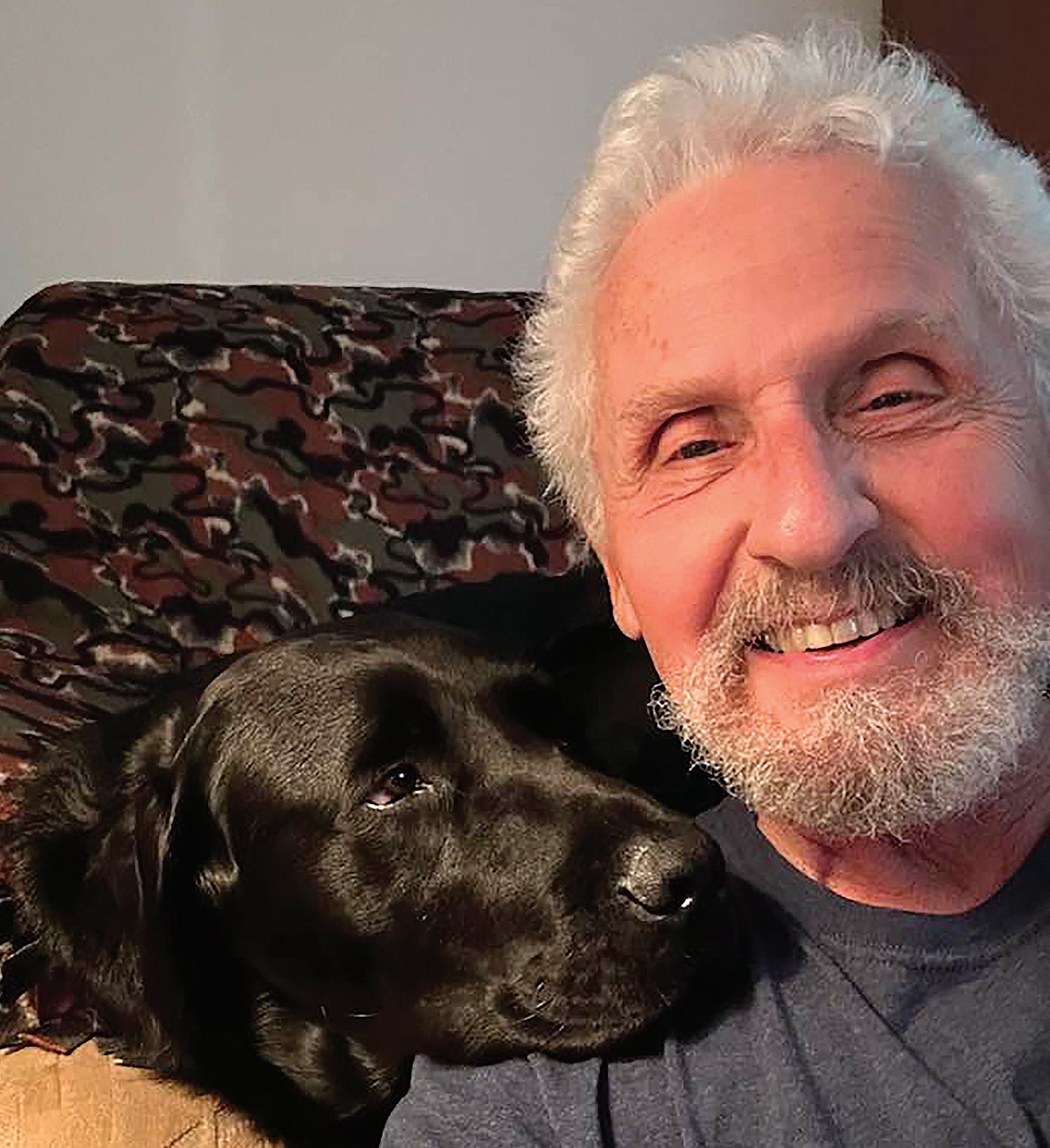
If you or someone you love is struggling with thoughts of suicide, call the Suicide & Crisis Hotline at 988. You are not alone.

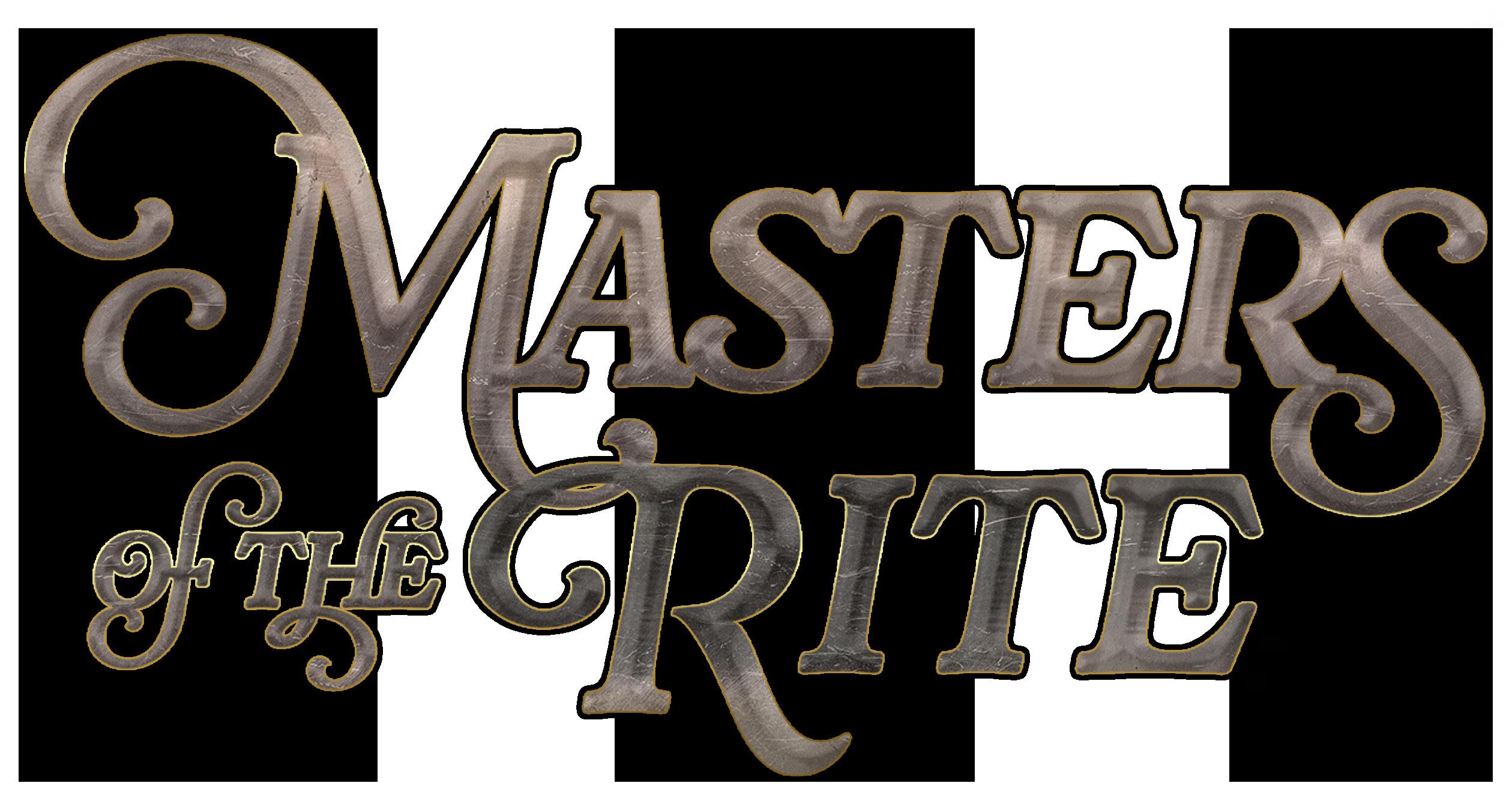

YOU ASKED FOR MORE
we Listened
Masters of the Rite returns for its second season. Our online degree education program that takes you deep into the heart of Scottish Rite teachings.
Led by Ill. Brother William “Sandy” Karstens IV, 33°, this live, monthly workshop partners with Thursday Night at the Rite, offering rich discussion, insight, and reflection on the timeless lessons of our degrees.
Schedule of Events
FIRST SESSION
JANUARY 22, 2026, 7PM ET
THIRD SESSION
MARCH 19, 2026, 7PM ET
SECOND SESSION
FEBRUARY 19, 2026, 7PM ET

About your Host
Ill. Brother William “Sandy” Karstens IV, 33°, from the Valley of Burlington (VT), is a seasoned leader in Freemasonry and a former physics professor with a distinguished academic career. His deep knowledge and passion for the degrees of Scottish Rite Freemasonry makes him the perfect guide for the Masters of the Rite.
Discover deeper meaning. Strengthen your connection. Join us for Masters of the Rite. ScottishRiteNMJ.org/Masters-of-the-Rite
BREAKING BOUNDARIES FOR
Children’s Dyslexia Centers Partner with Empowered
In early spring of this year, a new opportunity emerged to bring the mission of the Children’s Dyslexia Centers (CDC) to a national stage. Sovereign Grand Commander Walt Wheeler, together with Dan Quattrocchi, Assistant Operations Manager of the CDC, connected with the national public television series Empowered, hosted by Academy Award–nominated actress Meg Ryan.
That first conversation sparked immediate interest on both sides. The result: plans for a feature segment set to air in fall 2025 entitled “Breaking Boundaries for Neurodiversity: Dyslexia.” The collaboration quickly grew into a multifaceted project – an informational commercial, an educational documentary, and a national television segment – all designed to shine a spotlight on dyslexia, the children affected by it, and the transformative power of CDC tutoring.
Building the Story Together
From the beginning, the CDC’s clinical leadership team recognized the potential of this project to educate the public and elevate awareness of dyslexia’s impact on children and families. To shape the story, Clinical Director Dr. Carin Illig, Associate Clinical Director Cindy AllenFuss, Senior Director of Marketing & Communications Linda Patch, and Senior Director of Support Services Jim Dill joined forces with Empowered producers to identify the strongest voices to bring forward.
Columbus Center Director Blythe Wood played a pivotal role, gathering current and former families willing to
share their personal journeys. Their experiences became the heart of the story: how children learned to read with confidence, how parents found hope, and how family life was transformed through the CDC’s science-based and proven regimented literacy program.
A Day of Filming in Columbus
When filming day arrived in Columbus, Ohio, the excitement was palpable. Families, tutors, and staff came ready to tell their stories, highlighting both
the science of CDC’s approach and the life-changing outcomes for children. The behind-the-scenes emotions of the day – laughter, nerves, and pride – are seen in the photos accompanying this article, conveying the genuine spirit of the Centers and the families they serve.
Families, tutors, and staff came ready to tell their stories.
As the cameras rolled, children and parents were prompted with thoughtful questions:
• Child: How has the tutoring you’ve received at the CDC improved your ability to learn and read? How has it changed your life inside and outside the classroom?
• Parent: What led you to seek help for your child, and what has your CDC journey meant for your family?
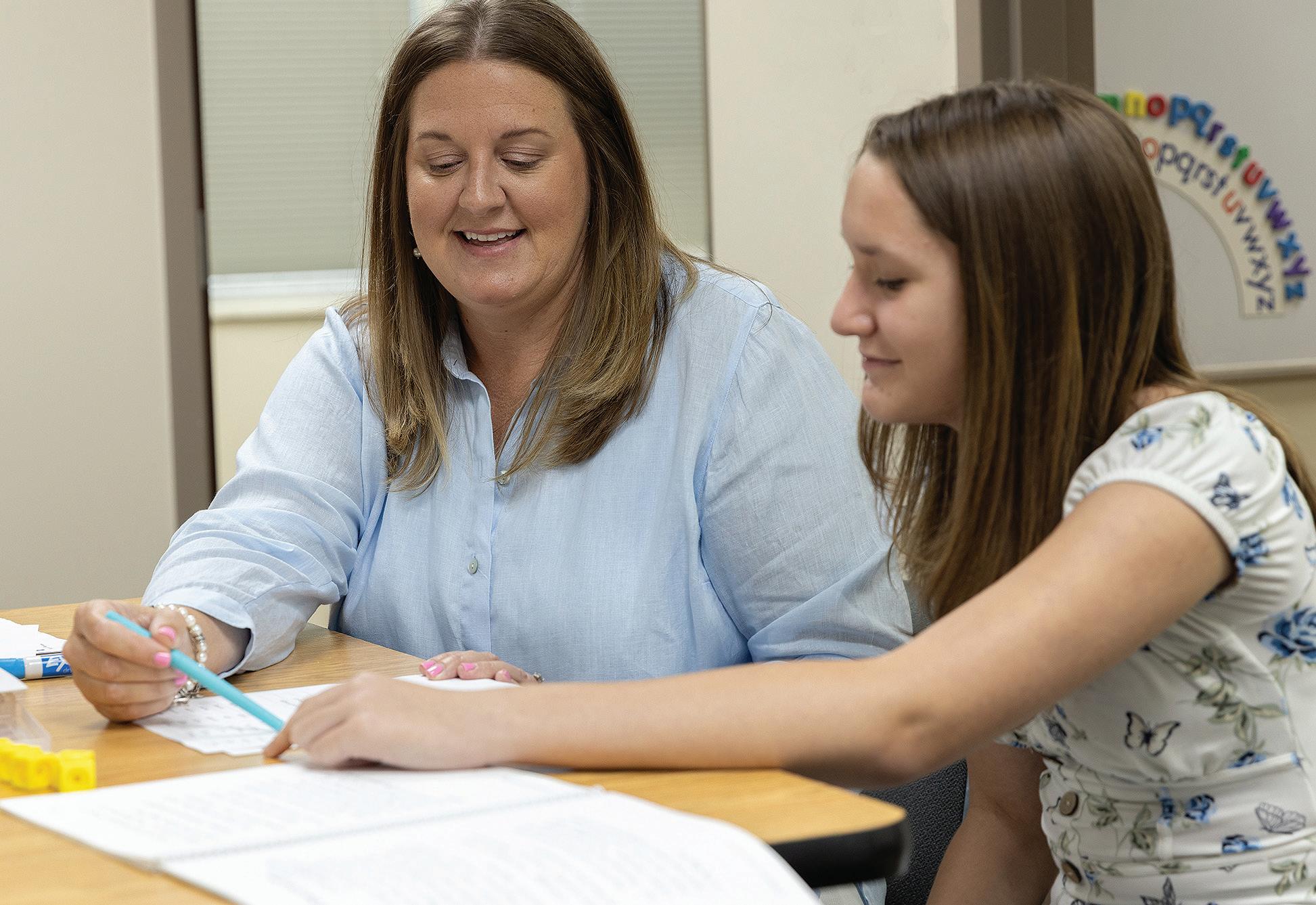

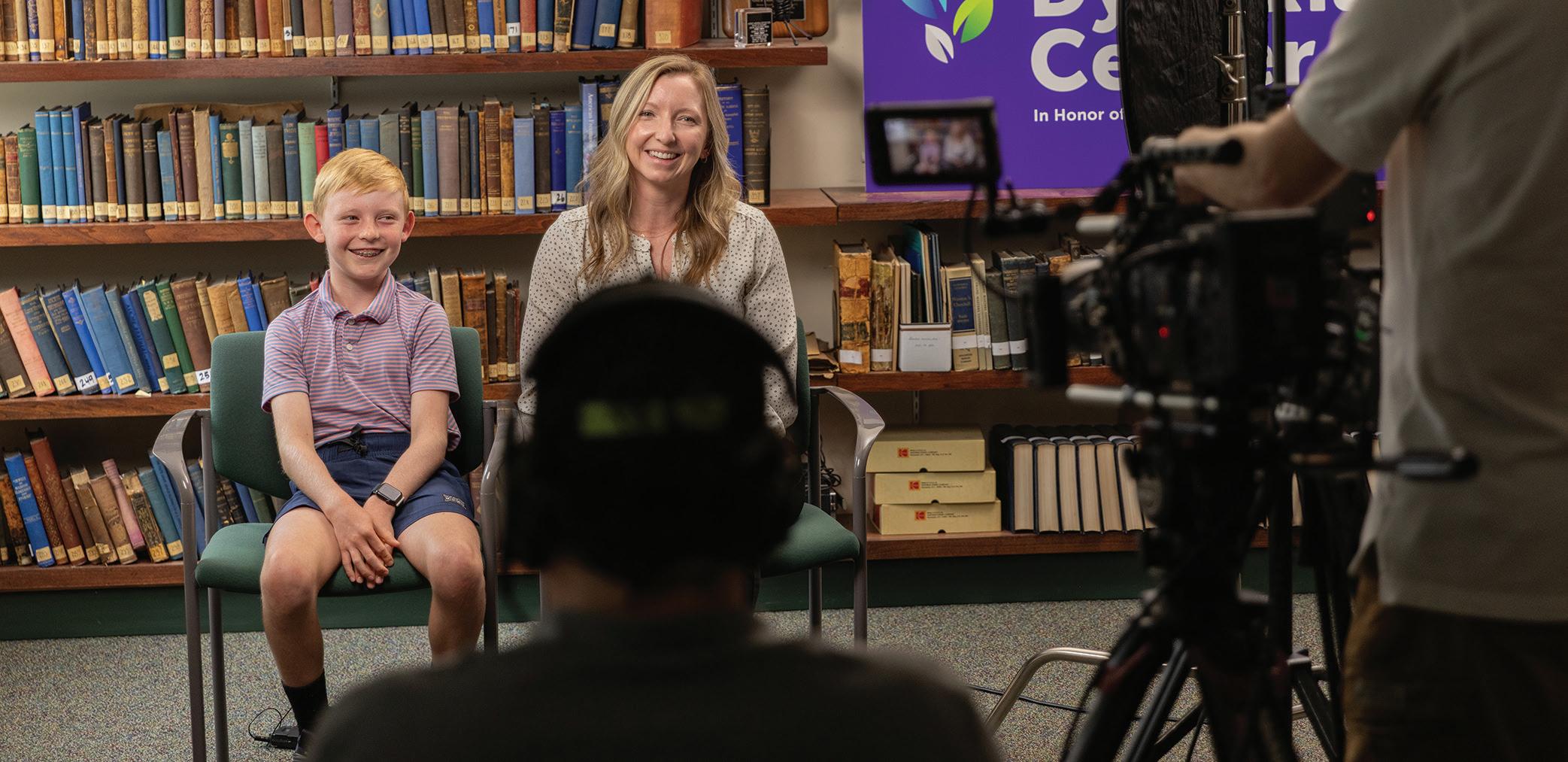
The responses were powerful, heartfelt, and inspiring – proof that the CDC story resonates far beyond individual families.
Looking Ahead
The final segment will begin airing nationwide on public television in October 2025, aligning with Dyslexia Awareness Month. With distribution across all 50 states, Empowered will reach millions of viewers, introducing the CDC mission to new audiences and strengthening the message to long-time supporters.
Beyond awareness, the project will serve as a valuable tool for fundraising, donor engagement, and community
education. The video assets –commercial, documentary, and national segment – will be shared not only on television, but also with partners, donors, Scottish Rite members, and communities invested in supporting literacy and neurodiverse children.
The Power of Your Support
For the Scottish Rite and the Children’s Dyslexia Centers, this collaboration underscores a simple truth: by telling our story on a national stage, we can inspire more families to seek help, more communities to understand dyslexia, and more donors to support this lifechanging mission. Every contribution to the CDC directly supports the training
To learn more, view the videos –or to join us as a supporter – visit: www.ChildrensDyslexiaCenters.org: www.EmpoweredProgram.com
To view the videos scan this QR code: !



of tutors and the delivery of one-onone instruction to children who might otherwise fall through the cracks.
CDC’s clinical leadership team recognized the potential of this project to educate the public.
Your support ensures that children with dyslexia receive the tools, confidence, and opportunities they deserve. Together, we can continue breaking boundaries for neurodiversity and expanding the reach of the Children’s Dyslexia Centers so more children, families, and communities can benefit from this life-changing work.
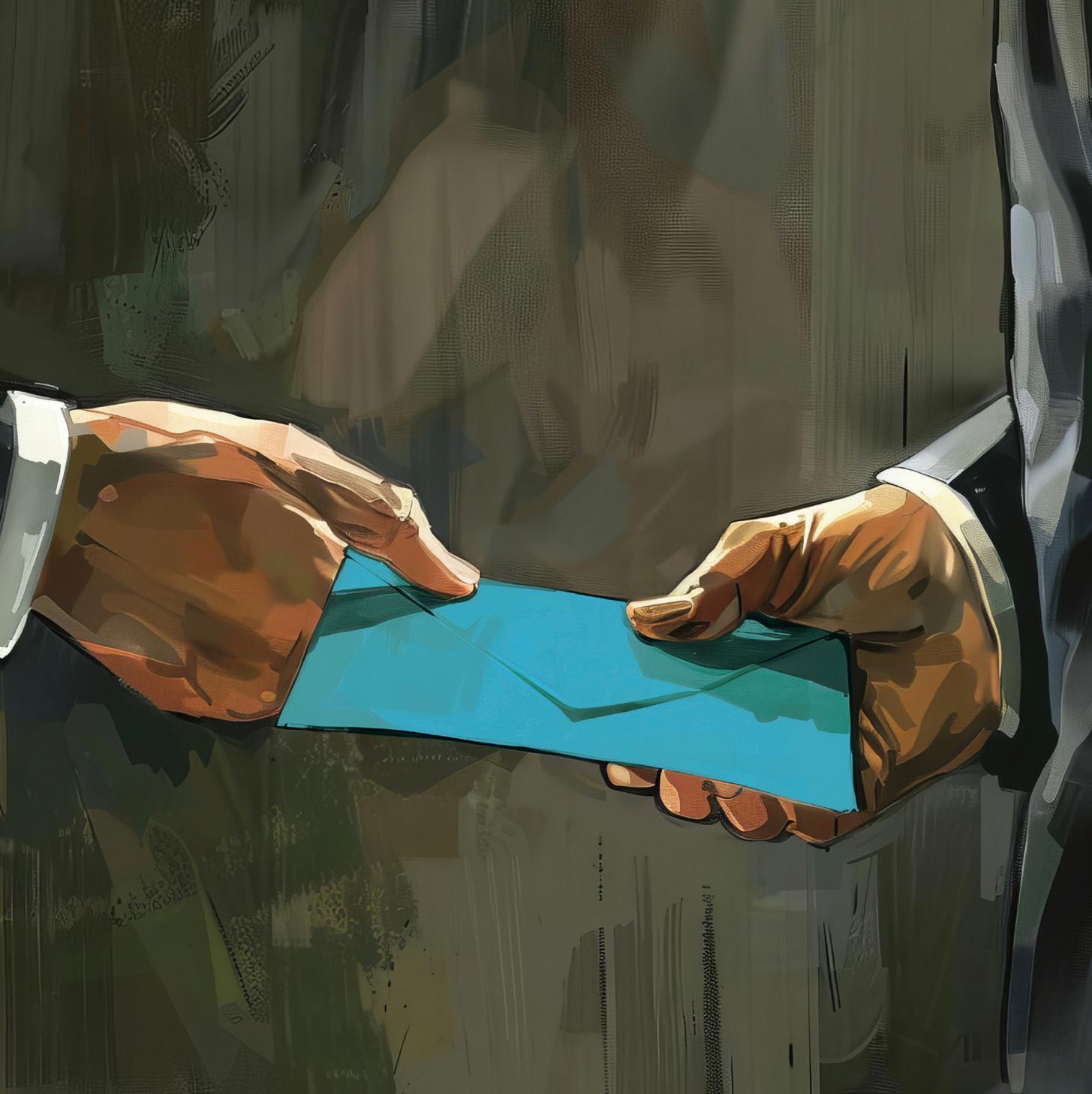
Can we beat tha t this year?
RAISED $538,987 77 FROM 7,396 BROTHERS
As the Scottish Rite’s oldest jurisdiction-wide fundraising appeal, the Blue Envelope is a tangible way for our fraternity to join together and fulfill our commitment to our Brothers and our communities. Donations to the Blue Envelope directly support our Scottish Rite Charities.
Just as you have a profound impact on our Scottish Rite Charities, Blue Envelope donations have a positive impact on your Valley. Every Blue Envelope donation helps your Valley get one step closer to becoming a Valley of Excellence.

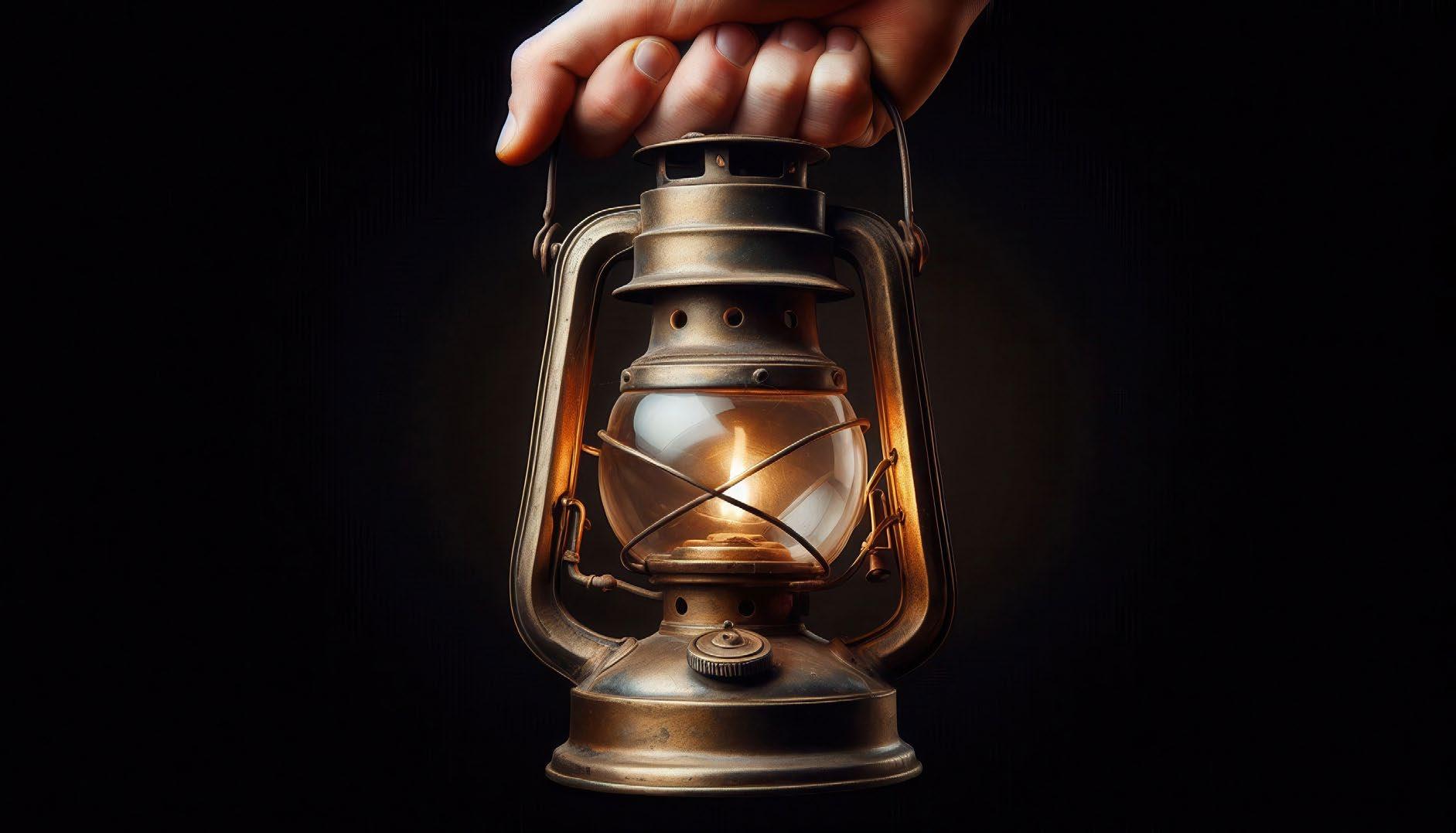
333 MILES. ONE MISSION. ONE
REVOLUTIONARY JOURNEY.
In April 2026, Bro. Patrick Atkinson, 32°, will lace up in Wilmington, Delaware, and run 333 miles to the Scottish Rite Masonic Museum & Library in Lexington, Massachusetts. His journey is a living tribute to the endurance and unity that shaped our nation and to the Freemasons who helped forge it.
The Revolutionary Run celebrates the 50th Anniversary of the Scottish Rite Masonic Museum & Library, raising funds to preserve the stories, artifacts, and legacy of Freemasonry in America through this symbolic 333-mile journey.
Learn how you can support Patrick’s journey at SRMML.ORG/REVOLUTIONARY-RUN

Patrick, a proud Scottish Rite Freemason, carries the weight of history and the strength of our fraternity in every mile. Each step honors the courage and unity that built this nation and the timeless stories preserved at the Museum. Your support along his journey helps keep that light burning for generations ahead.
Crafting Our Story and A Timeless Connection
Every generation of Freemasons receives lessons entrusted by those who came before. Each Mason has the privilege and the responsibility to tend those lessons, help them blossom, and pass them on to those who follow.
This year, we are proud to share new additions to two of our most important marketing initiatives — the Journey On and Not Just a Man. A Mason. campaigns. These efforts were born from two simple but powerful ideas: connection and legacy.
When you look back on your Masonic journey – the degrees you took, the moments of doubt, the times you felt alone – you realize something profound. You were never truly alone. Your Brothers were always there, sometimes unseen, but always by your side. That is the promise of your Craft. That is the true heart of your Brotherhood.
And that is what these campaigns aim to capture.

Crafting Our Story
The first of the new videos, Crafting Our Story, is more than a commercial. It is a reminder of everything good and enduring about your Brotherhood.
Working with filmmakers who understand the soul of Freemasonry, we sought to tell a story that reaches into the heart. The result is a reflection of the Scottish Rite as alive, vibrant, and modern – a Brotherhood that remains true to its timeless values while speaking to today’s men.
In the video, you will recognize characters who represent all of you:
by Linda Patch, Director of Marketing and Communications
• A young man searching for direction who finds it through Brotherhood.
• A Brother who steps forward to lead when leadership is needed most.
• Brothers who know that when one rises, all Masons rise together.
Crafting Our Story reminds us that the Scottish Rite is not just about ritual and degrees. It is about connection. It is about Brotherhood. It is about a deeper purpose that calls each of you forward.
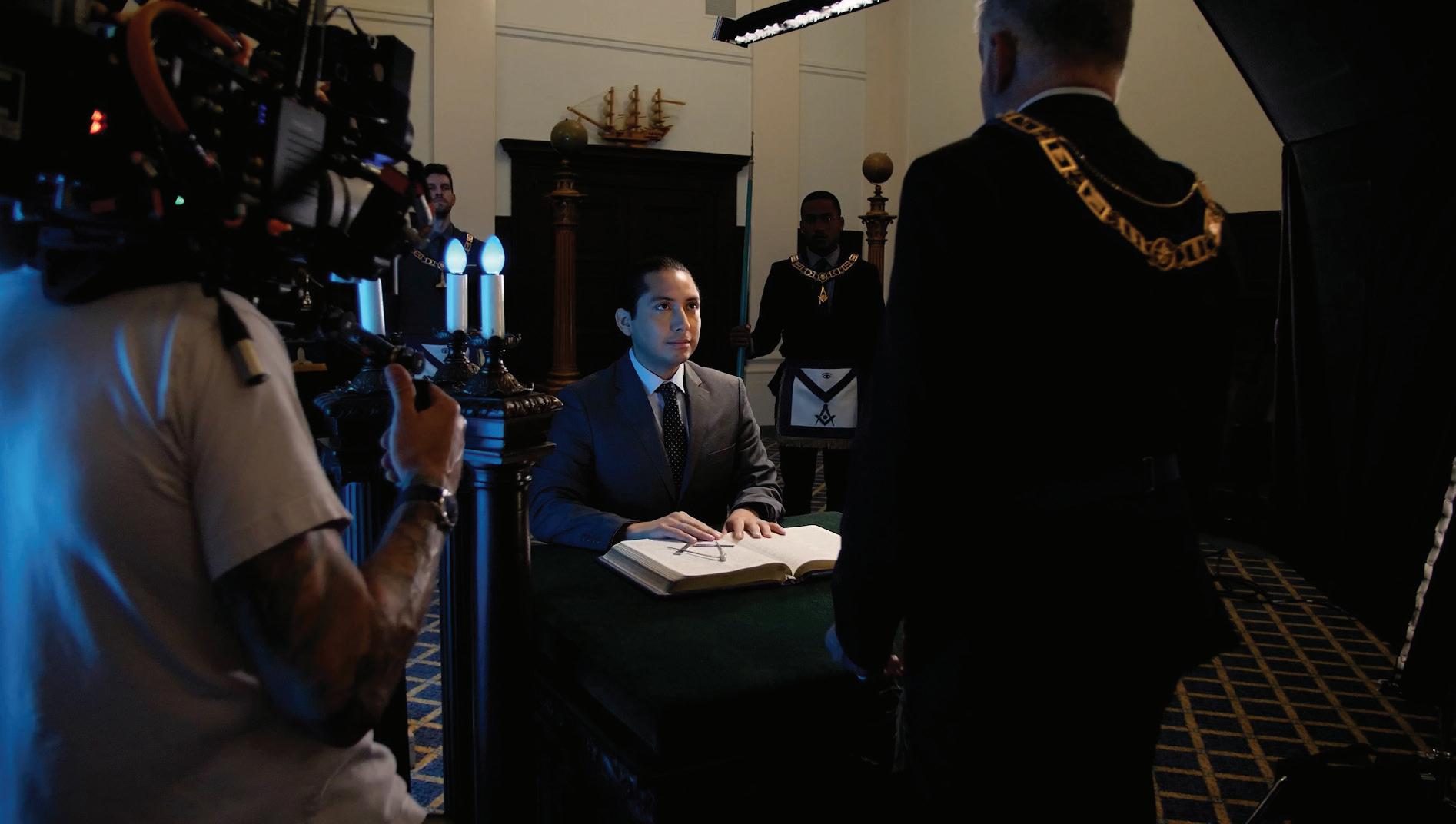


Behind the Scenes
We also present a video that takes you inside the process of bringing these stories to life. You will see the passion and commitment of those working behind the scenes – craftsmen dedicated to capturing the honesty, heart, and respect that Freemasonry deserves.
This glimpse behind the curtain reminds us that storytelling itself is a form of craft. Just as Masons shape stone and build enduring structures, we too shape stories – ones that will endure for generations.

Timeless Connection
Finally, Timeless Connection brings us to where every Masonic journey originates: that first spark of awe and excitement. The journey that begins in the heart.
In this piece, young men discover the Craft for the first time, finding the same wonder that Masons did 200 years ago. Their experiences connect directly to a far greater story.
At its core, Timeless Connection affirms a simple truth: Freemasonry is not a chapter that ends, but a journey that continues. You are bound together across time by a call to keep moving forward – ever onward, ever together.

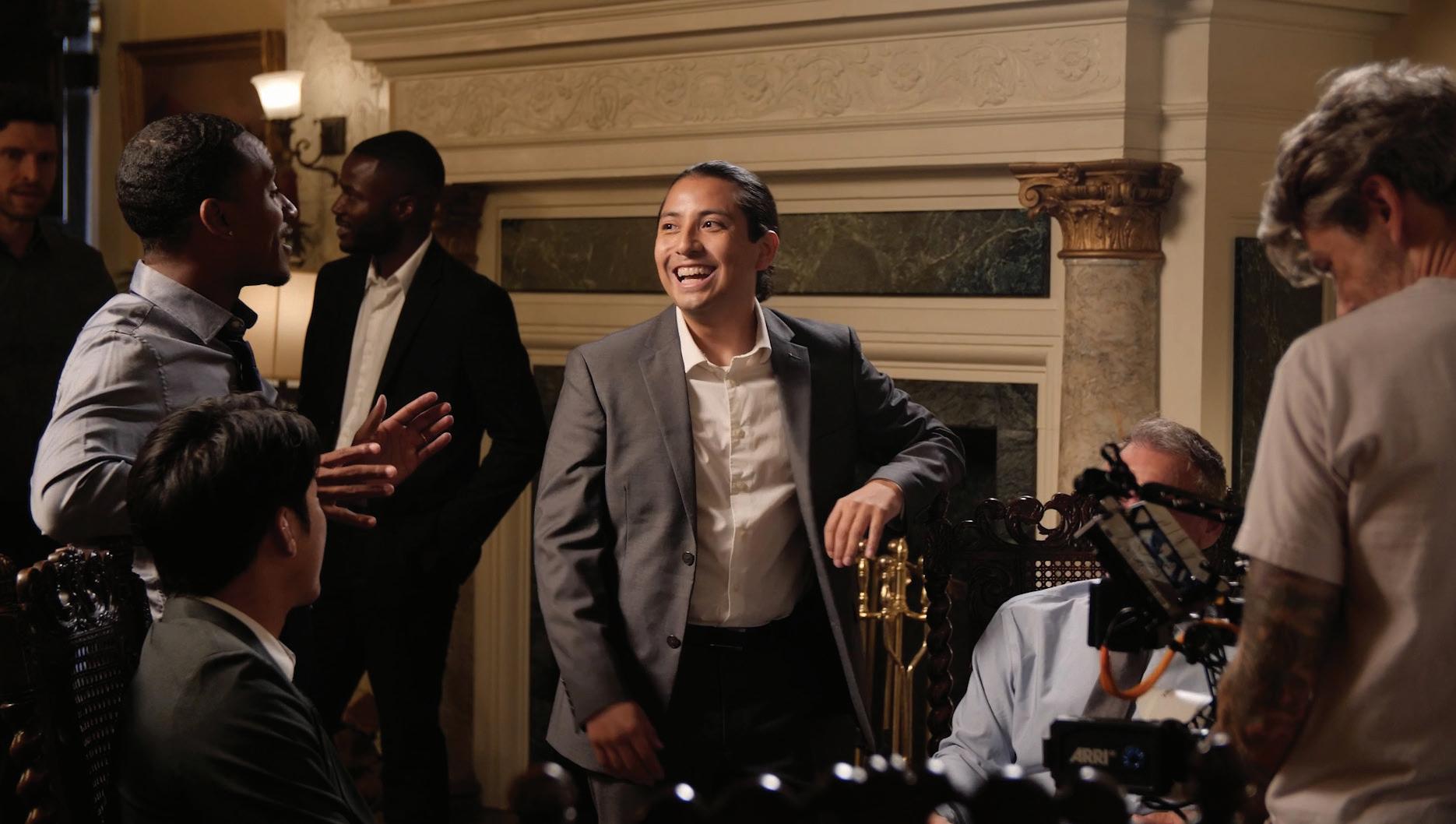
Campaign Videos and Customization Options
All campaign videos are available at scottishritenmj.org/ njam/videos. Many are also offered in 30- and 15-second formats for your convenience.
You are welcome to use the campaign assets as presented, or we can customize them with your call-to-action, URL, or other specific needs.
For customization requests, please contact us: Erik Fattrosso
efattrosso@srnmj.org 781-465-3316


Walking the Rite Path
On a recent sunny fall day in New England, the Scottish Rite Valley of Concord team participated in the annual Walk a Mile in Their Shoes event. The purpose of the event is to raise funds, awareness, and support for THRIVE, formerly known as the Crisis Center of Central New Hampshire. The center provides critical services, counseling, legal assistance, food, clothing, etc., to victims of domestic violence, sexual assault, and human trafficking in Merrimack County, New Hampshire. The Valley of Concord Team, named “Walk the Rite Path,” raised hundreds of dollars for this worthy cause. The cause aligns very well with our Masonic values, which remind us to help those less fortunate, protect the vulnerable, and support our communities.

Around the Jurisdiction


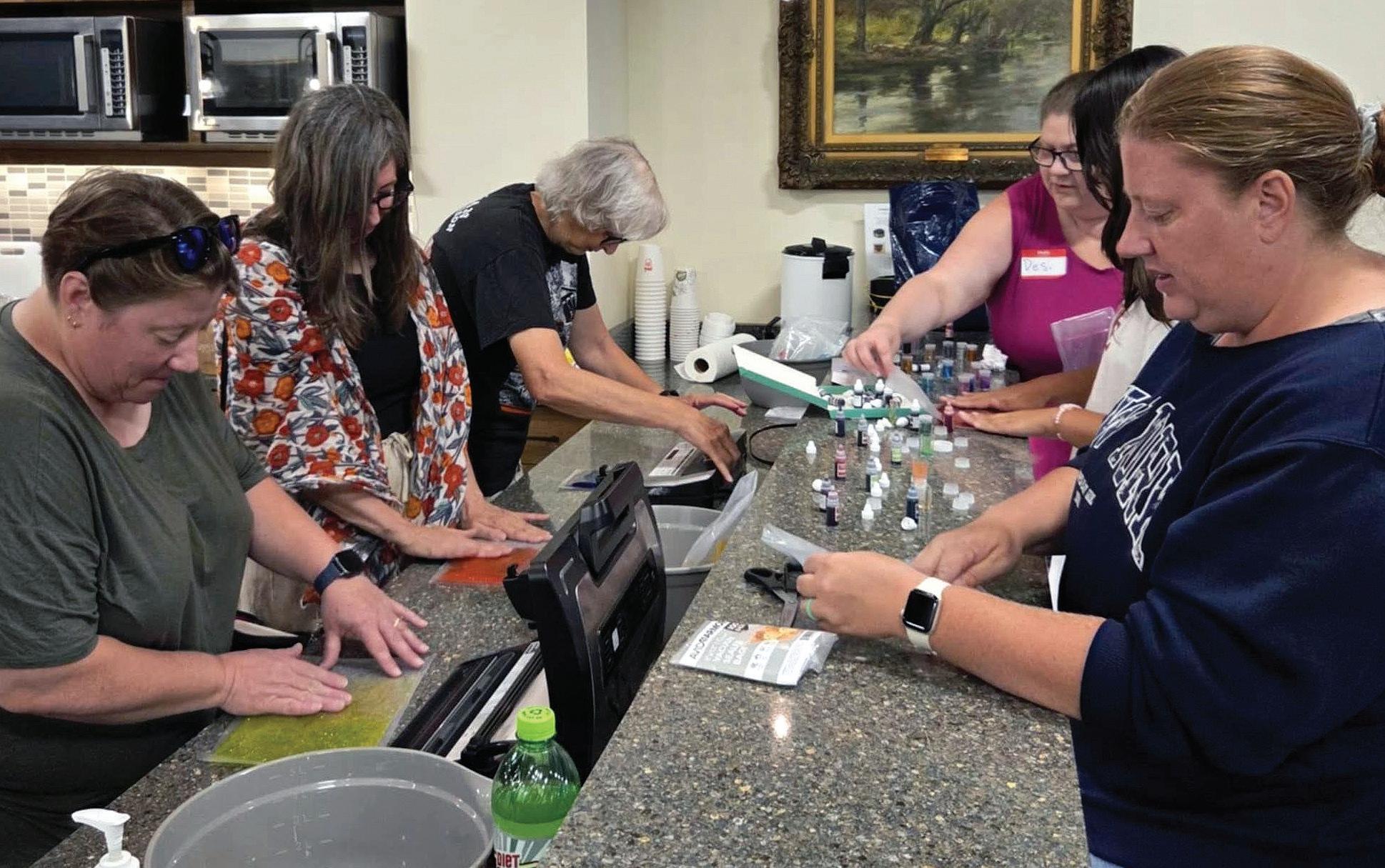
The Valley of South Bend had a great turnout for their annual family picnic.
The ladies of the Valley of Milwaukee helped supply the CDC while the Brethren held a Scottish Rite degree discussion.
Mark Ciarametaro, 33°, MSA, and his wife, Kelly, championed the Valley of Concord team.
Installation and Degree Day at the Valley of Greenfield

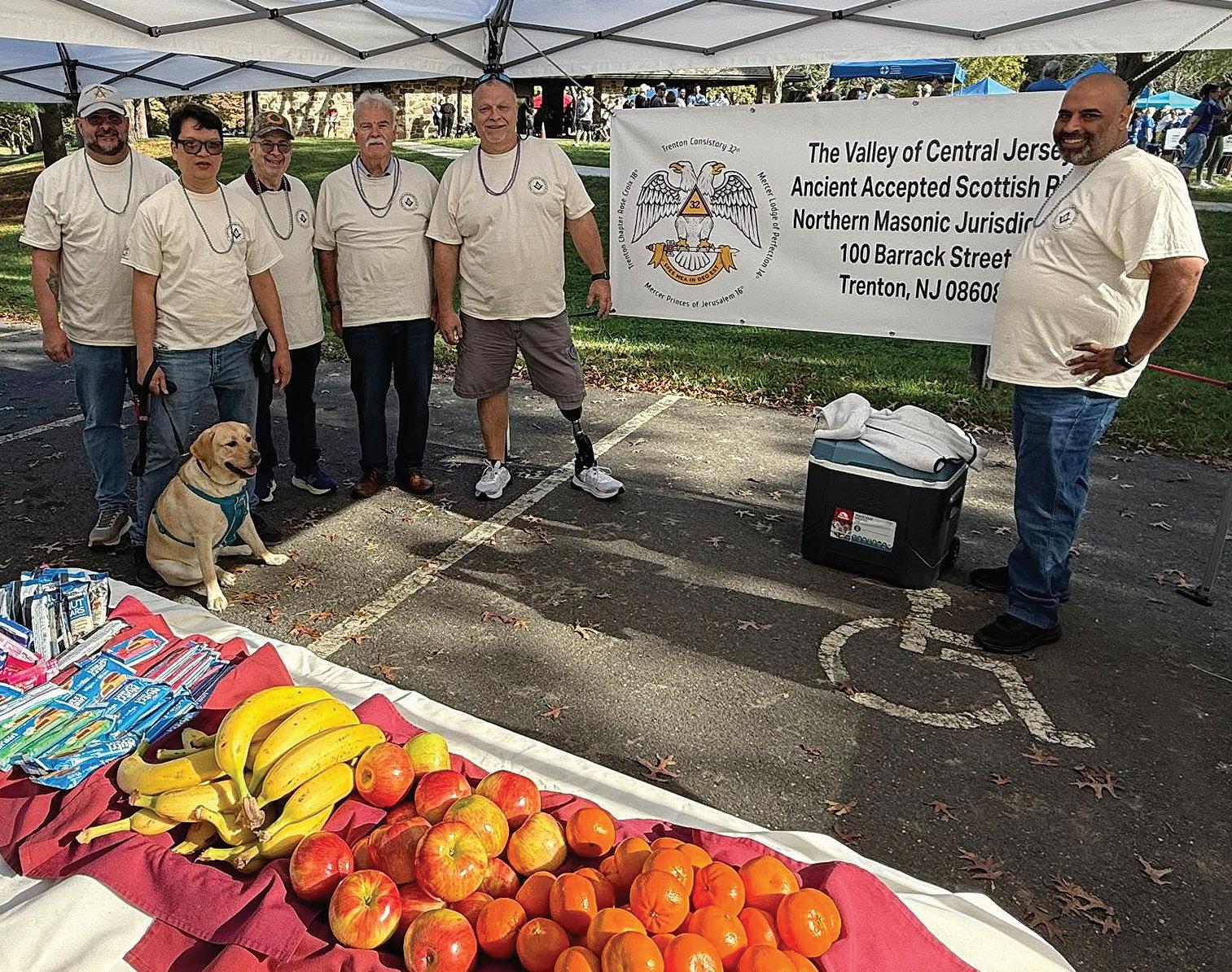

Valley of Schenectady Honors Ill. Peter J. Samiec, 33°
At the Annual Meeting of the New York Council of Deliberation in June, members of the Valley of Schenectady presented a check for $10,000.00 to Walter F. Wheeler, 33°, Sovereign Grand Commander, as a contribution to the Grand Almoner’s Fund, in honor of Illustrious Peter J. Samiec, 33°, Past Sovereign Grand Commander. This contribution is the first of a ten-year commitment by the Valley to support the Grand Almoner’s Fund, a project near and dear to Brother Samiec, our former Grand Almoner. The Valley of Schenectady is very proud of the work and commitment of Commander Pete and felt that contributing at the Diamond level of the Commander’s Circle was a way to recognize his efforts over the years. Brother Samiec was surprised and humbled by this contribution, and thanked the Valley members for honoring him and his favorite charity.


Members of the Valley of Philadelphia and their families brave the summer heat for their annual picnic.
Members of the Valley of Providence paid a visit to their Brothers in the Valley of Norwich.
The Valley of Central Jersey supported the Out of the Darkness Suicide Prevention Walk with a food and water station.
Walter F. Wheeler, 33°, Sovereign Grand Commander, recieves the contribution to the Grand Almoner’s Fund.
Around the Jurisdiction
continued
The Valley of Reading performed the 20th degree in the lodge room and welcomed four new Scottish Rite Masons.

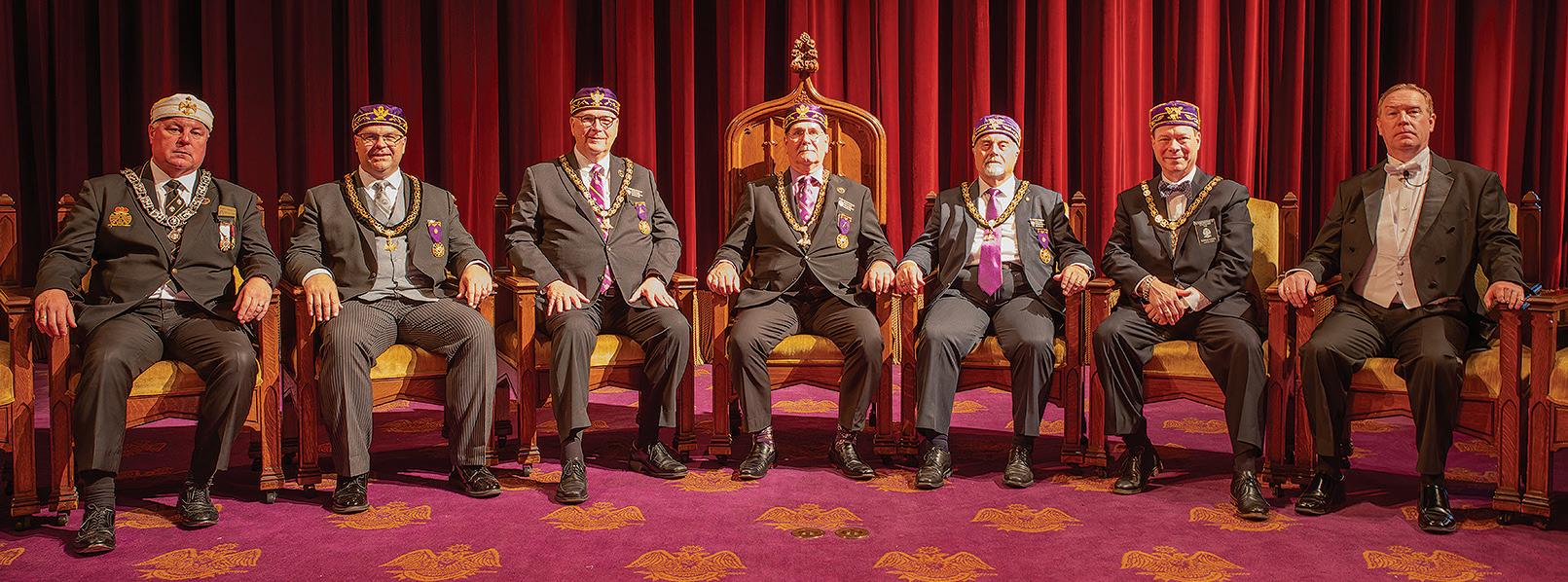

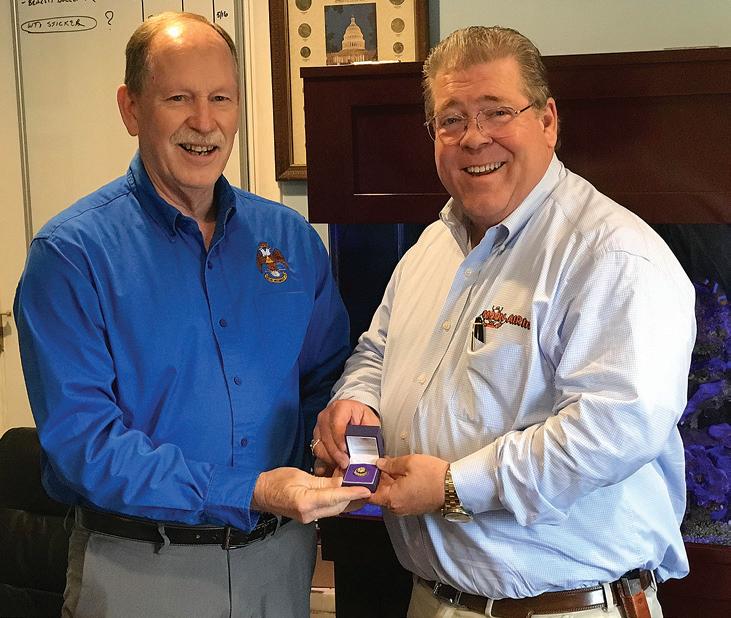
Ohio Grand Master’s Class
On September 12 – 14, Ohio held a Grand Master’s “Masonic Weekend” at the Canton Masonic Temple. This historic partnership between the Grand Lodge of Ohio and the Scottish Rite was a way to join Freemasonry and the Scottish Rite on the same day. To be eligible for the class, candidates were required to join both bodies. Following the Craft degrees, nine Valleys conferred live Scottish Rite degrees.
All Grand Lodge Officers were in attendance, with all six Ohio Actives,and five Deputy’s Representatives. The Ohio Council of Deliberation sponsored the meals for candidates and their mentors.
Total attendance for the weekend was nearly 550, with 129 new members created that day.
It was an inspiring and exciting event that created a lot of buzz which many are still talking about!

Brother Steve Moon received his Commander's Circle pin from Ricky Swalm, Deputy for Delaware.



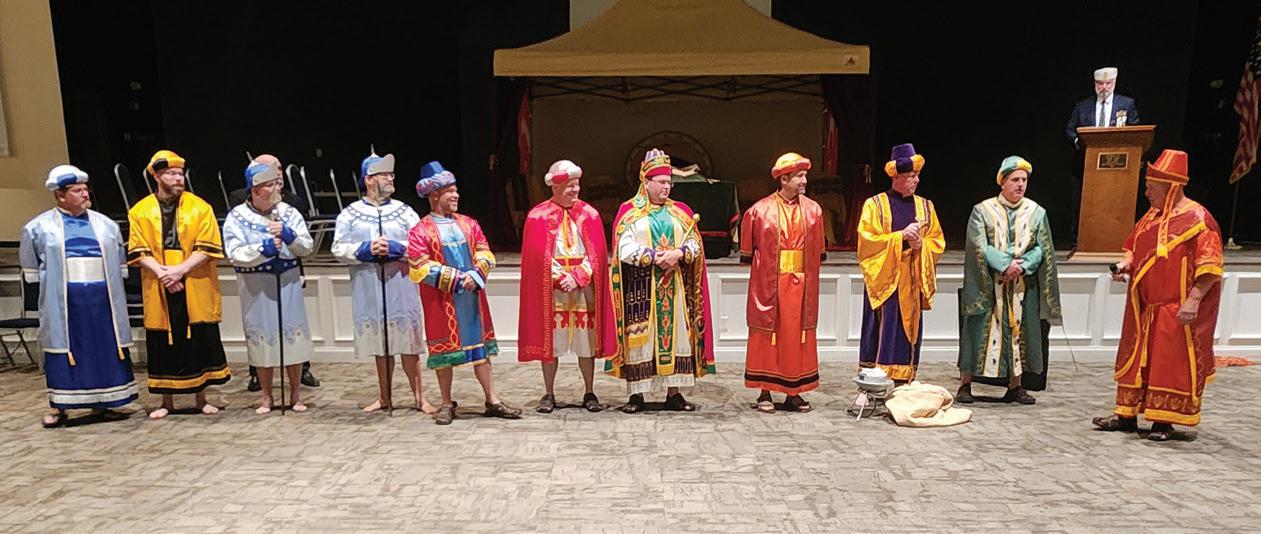


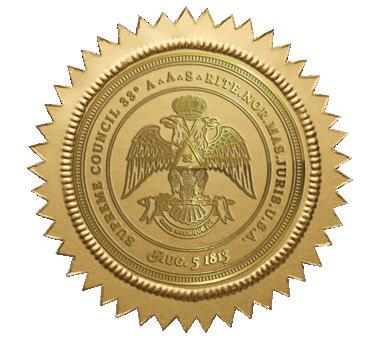


The Valley of The Green Mountains held their annual meeting in South Burlington.
Congratulations to the newest Valley of Michigan members from the Sault Ste. Marie Fall Masonic Day. MI
The Valley of Bangor hosted this year's Grand Master's Class.
The Valley of Michigan Southeast Region boarded the Yacht Infinity for a fall cruise.
MI
Brother Sichan Siv Leads with Hope, Humility, and Humor
by Joann Williams-Hoxha Content Manager

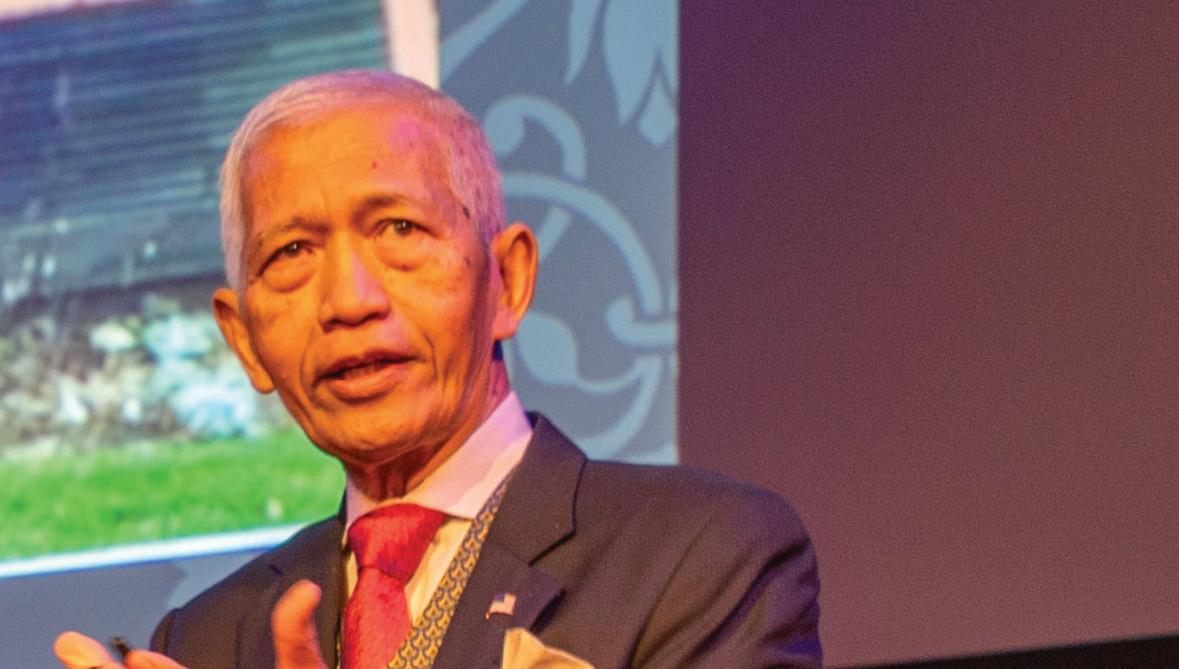


On June 4, 1976, Brother Sichan Siv arrived in the United States from the Killing Fields of Cambodia with two dollars, his mother’s scarf, and an empty rice bag.
“I
was sick and tired, but I was full of hope,” he relayed to a captive audience at Supreme Council’s Annual Meeting in Indianapolis on August 25th.
In the spring of 1975, as the Vietnam War spilled into Brother Siv’s home country of Cambodia with attacks from the Khmer Rouge, he was working with CARE, a U.S. relief organization that provides help to people in wartorn countries. Through his work with CARE, Brother Siv received placement on Cambodia’s evacuation list, but Embassy officials told him that he would only have a small window of time to report to the U.S. Embassy to be airlifted out.
The time for departure came on April 12, 1975, but Brother Siv chose to attend a meeting with a governor as they worked to save the lives of 3,000 refugees stranded in the governor’s province.
When Siv arrived back at the Embassy, he learned the last helicopter had taken off 30 minutes before his arrival. Those 30 minutes would forever alter the direction of his life.
“Five days later on April the 17th, the Khmers came in, and they turned the
country upside down,” Siv said. Teachers, nurses, government officials – anybody who had not been a part of the “so-called revolution” – were killed.

“My mother gave me her wedding ring, her scarf, and a bag of rice. She told me to run,” Siv relayed. His mother said, “No matter what happens, never give up hope.”
“Five days later on April the 17th, the Khmers came in, and they turned the country upside down.”
For three weeks, Brother Siv rode a bike across Cambodia until he was captured near Thailand. Khmer Rouge forces nearly killed him, as they suspected he was trying to cross the border. This “was exactly my intention,” he recounted defiantly.
Through a stroke of good fortune, or what Cambodian people call “golden bones” to describe someone exceptionally lucky, a truck driver vouched for him, telling Khmer forces
that Siv was innocent and just looking for his family.
Still, luck could only take him so far. By the next year, he was in a forced labor camp working 18 hours a day and subsisting on a bowl of rice, never knowing if he would live to see the next day.
“Each new day I woke up, I vowed to make it to freedom,” he said.
In February 1976, Brother Siv jumped on the top of a fully loaded logging truck with one thing on his mind: Freedom.
“I couldn’t jump to the left, because the driver would have seen me. And I couldn’t jump to the right, because a Khmer soldier with an AK-47 would have seen me. So I crawled on top of the timber and dropped
Sichan teaching English to refugees
HOPE, HUMILITY, AND HUMOR

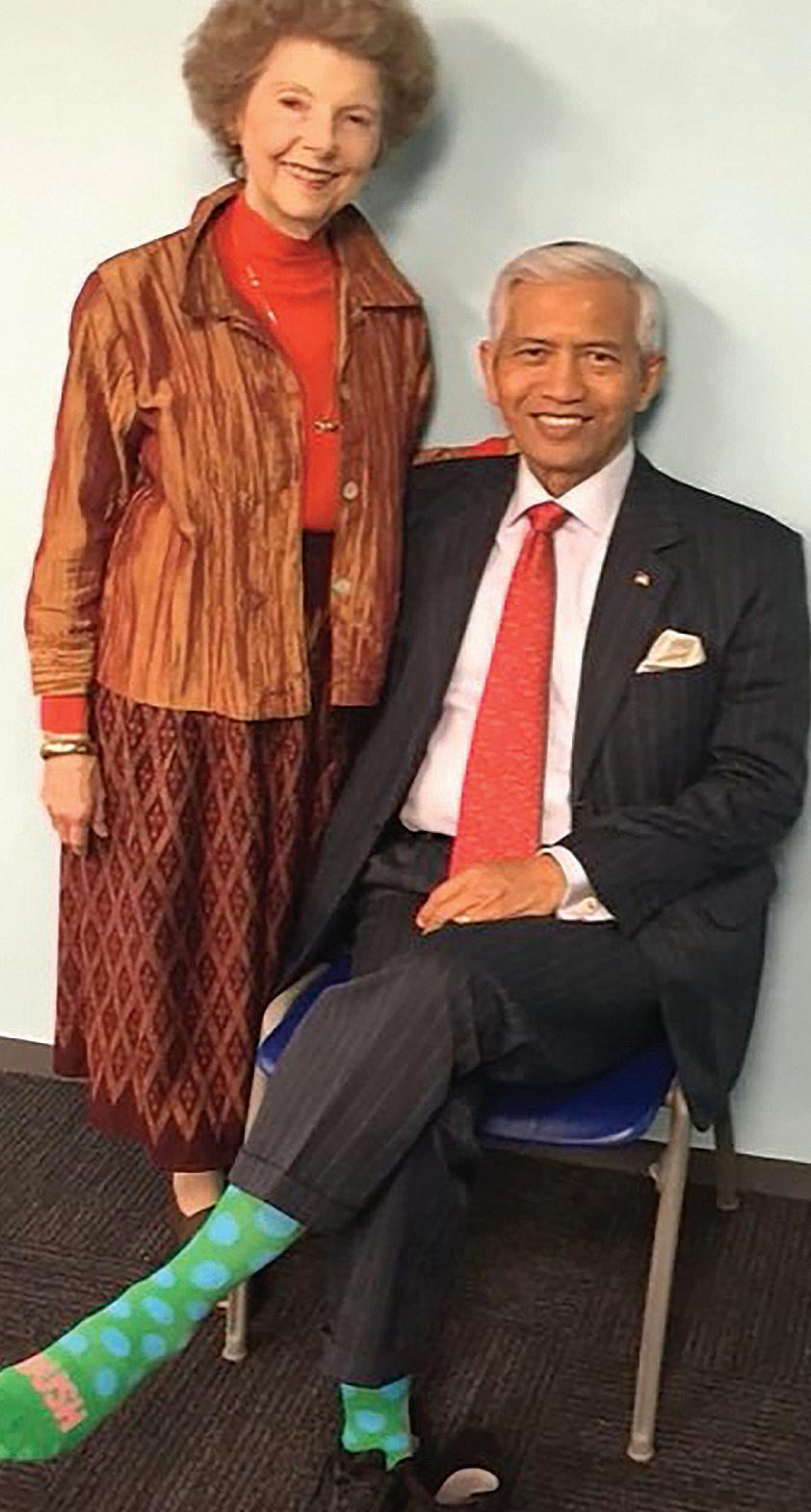
myself behind the truck. I got caught on a piece of lumber and dragged a few hundred yards before I was flung off.”
He ran three days with no food or water, “and nothing to guide me except the sun, the stars, and the moon,” he said.
Wounded from a booby trap but alive, he eventually reached Thailand, where he spent several months in a refugee camp teaching English to fellow refugees, providing a path to hope and humanity for fellow survivors. A new start for Brother Siv was on the horizon.
A family from Wallingford, Connecticut, welcomed Brother Siv into their home as a refugee, where he says he picked countless apples off the trees and ate enough of them to last him a lifetime. He gained employment at the local Friendly’s restaurant, which was quite a culture shock and one of the most difficult jobs he said he has ever held.
By the next year, he was in a forced labor camp working 18 hours a day and subsisting on a bowl of rice.
“I had never seen a hamburger in my life,” he recalls. And when the Friendly’s trainer told Sichan to ‘hold the lettuce,’ he took that directive quite literally and gripped the lettuce in his hands.
In January 1977, Siv moved to the Big Apple. If working at a restaurant was tough, certainly driving a cab must be easier, Siv relayed. He applied to drive a yellow cab, and the employer gave him a written test with questions like, “How do you go from Madison Square Garden to Yankee Stadium?” With no

idea where these places were, Siv simply checked all the boxes on the test and handed it to the examiner, who shook his head, frowned, and told Siv, “You passed.”
Brother Siv said “a strong horn and good brakes” got him far in New York City, where he eventually met his wife, Martha.
“When I met Martha, she opened new horizons for me. How to look far, to see, listen, to hear, learn to live, love to give, and live to serve. For serving others is serving God and country,” he said fondly. Sadly, Brother Siv’s wife, Martha, passed away in 2016.
Brother Siv completed his master’s degree in international affairs at Columbia University and became a U.S. citizen in 1982. He served as a volunteer in George H. W. Bush’s 1988 presidential campaign and was then appointed as the President’s deputy assistant from 1989-1993 and in the State Department as deputy assistant secretary. In 2001, he was unanimously confirmed by the Senate and appointed by President George W. Bush as the United States ambassador to the United Nations Economic and Social Council, a position he held until 2006.
Brother Siv is a member of Charles W. Robinson Lodge No. 1413 and the Scottish Rite, Southern Jurisdiction’s Valley of San Antonio, Texas. He is the author of Golden Bones: An Extraordinary Journey from Hell in Cambodia to a New Life in America and Golden State: Love and Conflict in Hostile Lands.
Sichan and wife Martha
Sichan’s Yellow Cab License


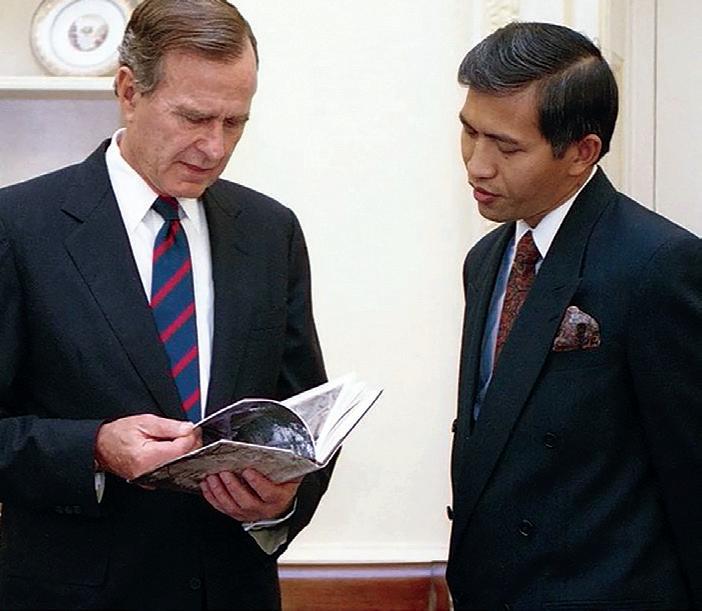
At the end of Brother Siv’s talk in Indianapolis, he relayed the meaning of “golden bones” to the audience and closed by saying, “I think all of us are people of golden bones, because we’re blessed. We are lucky to be in this very, very important Fraternity together.”
Following a standing ovation, the Sovereign Grand Commander presented Brother Siv with the Daniel
To watch Brother Siv’s full presentation from the Annual Meeting, scan the QR Code or visit: https://vimeo.com/1118175366
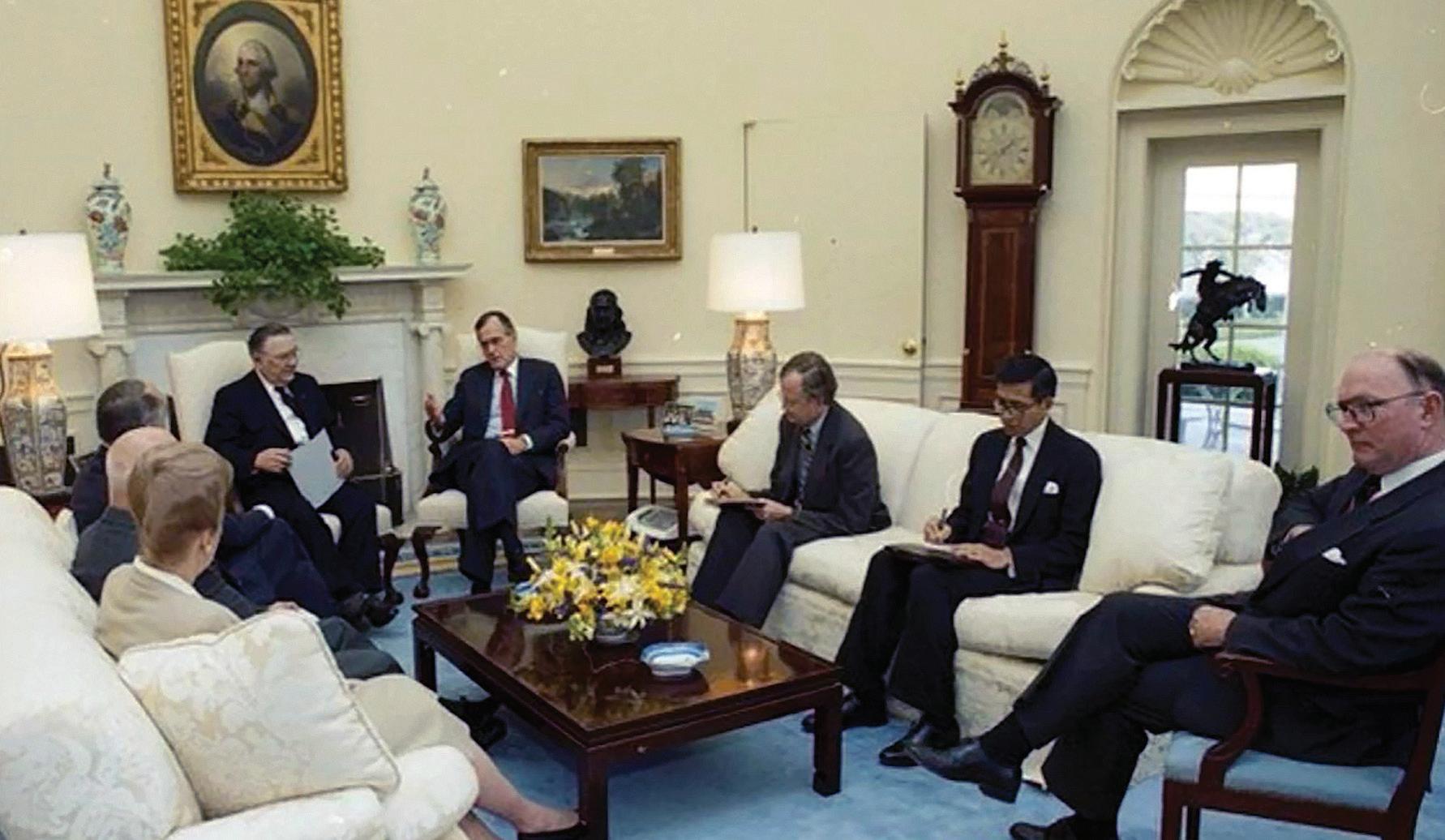
D. Tompkins Medal for his incredible service to his country and the Masonic Fraternity at large. Supreme Council confers the Tompkins Medal to honor distinguished contributions not often witnessed by the general membership.

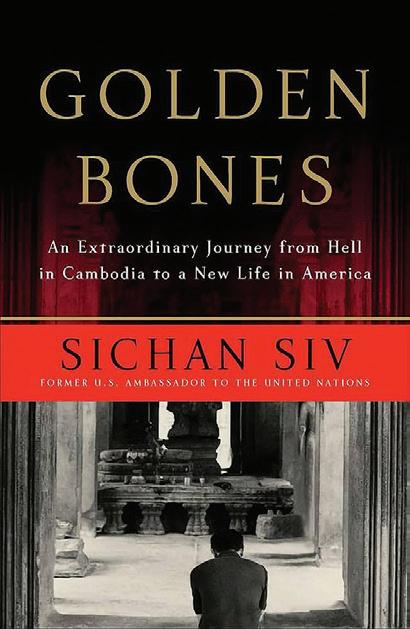


President Bush with Sichan
The Cabinet meets in the Oval Office
Siv received a portrait by Travis Simpkins from the Commander.
A Christmas card from the Bushes
Freemasonry and the Upswing in America’s Civic Rebound
by Roger VanGorden, 33˚, Active for Indiana
This essay follows the themes in “Freemasonry as the Third Place,” which appeared in the previous issue of The Northern Light. That article explored how Freemasonry uniquely fulfills sociologist Ray Oldenburg’s concept of the “third place,” a neutral ground for meaningful connection beyond home and work. If that is the case, the next question is: What role can such a place play in America’s civic future?
As noted previously, the theme song from Cheers captured something lasting: “Making your way in the world today takes everything you’ve got. Taking a break from all your worries sure would help a lot.”
This is sociology, not merely quaint lyrics. And they speak to the very need Freemasonry is equipped to meet.
In his book The Upswing, political scientist Robert Putnam traces a broad arc in American history. Putnam demonstrates a movement from individualism toward community in the early 20th century, followed by a retreat to individualism after the 1960s. Remember the “Me Generation?” Civic engagement, social trust, and community involvement rose together. Then, they fell together. Fraternal organizations, civic clubs, and churches all mirrored this trajectory. So did Freemasonry.
Putnam’s earlier work, Bowling Alone, captured this collapse of social capital. Fewer people joined clubs starting in the 1960s. Neighbors didn’t know each other. Participation shrank. What was lost wasn’t just membership rolls. What was lost was meaning. What was lost were those small, regular human
moments that add up to community. One example Putnam noted is that while bowling participation stayed relatively stable, the number of leagues plummeted. We were still bowling. We were just bowling alone. Freemasonry was one of those displaced sources of connection.
Freemasonry isn’t a social club. It’s a social movement.
In The Upswing, Putnam is sharper. He argues that the 1960s replaced the cooperative “we” with a culture of “unfettered self-interest,” an ethic that frayed the bonds of communal trust. But this shift wasn’t inevitable. And it’s not irreversible. As he reminds us, “the pendulum can swing back.” History shows we’ve done it before.
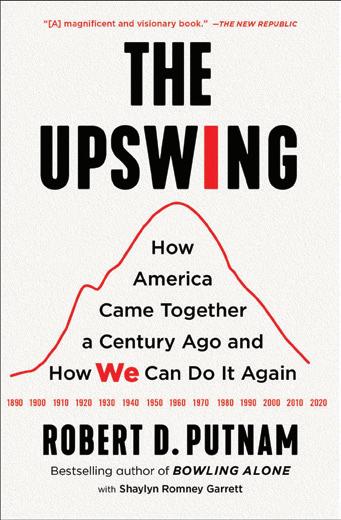
There is further proof. Recent studies show that men are feeling increasingly disconnected. A Stanford study found that one in five men reports having no close
friends. Among younger men, it’s worse. Gallup reports that one in four men under 35 struggles with frequent loneliness. While social media promised connection, both active and passive use have been linked to isolation. The digital world often replaces connection with distraction, scrolling instead of conversation. Men scrolling through the noise, looking for something that feels real. This is the disconnection Putnam warned about.
This cultural unraveling isn’t something abstract. It touches daily life, our friendships, our neighborhoods, and our capacity to build anything lasting. If the third place is disappearing, and social trust is unraveling, then the question becomes urgent. What institutions are left that still form character, cultivate community, and teach men how to belong? Where do men still go to be known, challenged, and changed?
Enter Freemasonry. It offers a radically different path: intentional, face-to-face fellowship.
Freemasonry isn’t a social club. It’s a social movement. One of the last, perhaps only, institutions where men are shaped not for show but for substance. And that shaping happens in person, with presence, through practice. This brings us back to Oldenburg and the third place. Freemasonry doesn’t merely align with Oldenburg’s third place; it may be the clearest surviving example. A space where men gather not for transaction, but transformation. Where the teachings, values, and shared experience bind men together.
Where presence matters more than performance.
Some complain that too much time is spent on ritual. But ritual is not a barrier. It’s a bridge. It connects the individual to the collective, the present to the past. It gives shape to identity and clarity to purpose. Freemasonry does not resist modernity out of stubbornness. It offers something modernity forgot how to value: the making of a man.
Recent studies show that men are feeling increasingly disconnected.
Other modern third places, such as gyms, sports leagues, and youth athletics offer camaraderie, but often without continuity. You play a season. Then you move on. Parents watch from the sidelines. Relationships stay casual. Freemasonry offers something deeper. It’s not entertainment. It’s investment.
We already know what Freemasonry is. We say that by improving the character of the individual, Freemasonry improves the community. But we often overlook what it could become. Freemasonry is not only a third place. It is a civic tool. A cultural resource. A ready-made response to disconnection.
The path forward lies not in new policies. It lies in renewed presence, purpose, and practice. If we believe Freemasonry shapes better men, then we must believe those men shape better communities. It begins within the Fraternity. But it must move outward.
Freemasonry is not a relic of the past. It is a remedy for the future. And if the upswing is coming, we don’t need to chase it. We need to open the door, set the working tools in place, and welcome it in.
Skeptics may ask: If that’s true, where’s the proof? The answer isn’t always in headlines. It’s in habit. Freemasonry quietly shapes civic leaders, teachers, volunteers, and mentors whose steady hands are formed by its teachings.
This isn’t a new mission. It’s a rediscovery of what was always there. Generations before us understood the civic impact of Freemasonry. Think for a moment about the Brothers whose names still hang on your lodge’s wall or the ones who helped shape your Valley’s place in the community. They lived it. Now it’s our turn. Rediscovery means more than remembering. It means doing.
Consider this: Freemasons don’t get together to have meetings. We have meetings to get together.
Because sometimes, a man needs a place where everybody knows his name and reminds him who he’s meant to be.
Puzzle solution from page 23
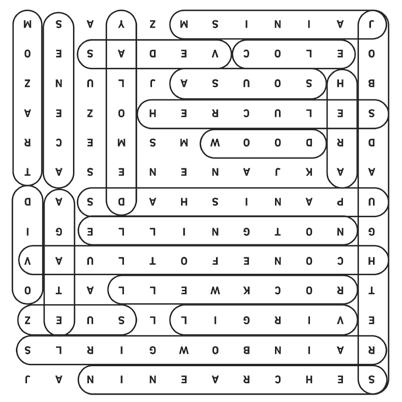
Deputy VermontofInstalled as Grand Master

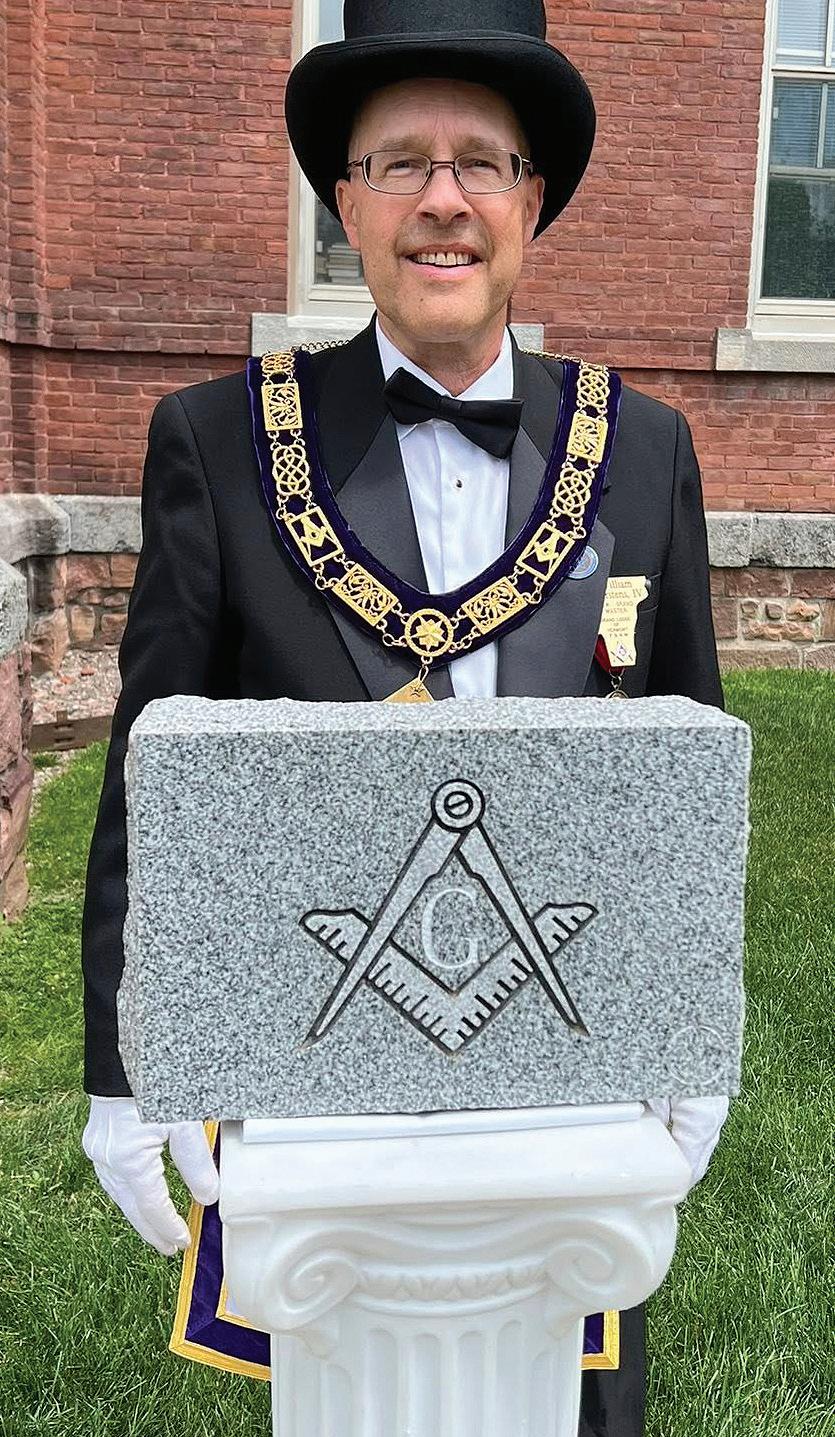
On June 11, Ill. William “Sandy” Karstens, 33°, Deputy and Active Member for our Supreme Council, was elected and installed as the Most Worshipful Grand Master of the Grand Lodge of Masons in Vermont.
“This distinguished honor represents not only a personal achievement of the highest order, but a testament to Brother Karsten’s unwavering dedication to the principles and ideals that have guided our ancient and honorable Fraternity throughout the centuries,” said Right Worshipful Gill R. Calderon of the Grand Lodge of New York.
Ill. William “Sandy” Karstens at a recent cornerstone laying ceremony at the University of Vermont
REMARKABLE MASONS:
Father and Son
by Stacey Fraser, Assistant Curator Scottish Rite Masonic Museum & Library
The Masons profiled here, a father and son, worked to advance the education and emancipation of Black Bostonians in the 19th century.

Abel Barbados (1755-1817)
East and North Elevations of the African Meeting House, Boston, 1934. Library of Congress. Abel Barbados helped construct this building in 1806.
BORN in Lexington, Massachusetts, to Quawk and Kate Barbados, Abel Barbados moved to Boston’s Beacon Hill neighborhood in the early 1780s. In 1782, he married Chloe Holloway of Hallowell, Maine, at Boston’s First Baptist Church.
In 1796, Abel purchased a lot at 19 Belknap Street, joining a growing community of Black Bostonians in the neighborhood. At this time, the Barbados family numbered six: Abel, Chloe, and their children Abel Junior, Mary, Clarissa, and James.
In 1800, Abel signed a petition in support of a school for children of African descent in Boston. According to an 1883 oral history, he drew on his skills as a brick mason to help erect the African Meeting House in 1806. This structure housed the African Baptist Church and African Lodge No. 459. Abel joined African Lodge, the first Black Masonic lodge in the country, in the early 1800s. He likely helped build the school first proposed in 1800 in the Meeting House’s basement after the building was completed.
Abel and Chloe had three more children after their move to Belknap Street: Robert, Catherine, and Isaac. Isaac, who later became Secretary of African Lodge No. 459, was named after Abel’s brother, who died of illness while serving in the Continental Army.
Abel passed on March 22, 1817, and is buried in Copp’s Hill Cemetery, Boston. More than a thousand Black Bostonians were laid to rest in this graveyard. Abel’s grave is one of the few still marked with a stone. It is a reminder of his legacy in building and sustaining important community institutions for Black Boston residents in the early 1800s.

James Barbados (1796-1841)
BORN in 1796, James Barbados was a baby when his parents moved to Belknap Street. As a young adult, he owned his own hairdressing and clothing businesses. He was raised in African Lodge No. 459 in the early 1820s. In 1826, he and other lodge members established the Massachusetts General Colored Association, which denounced segregation in Massachusetts and called for the abolition of slavery.
Five years later, James wrote a letter condemning slavery that was published in The Liberator, William Lloyd Garrison’s abolitionist newspaper. James also co-authored a segment in Garrison’s 1832 book, Thoughts on Colonization. In an argument against efforts to induce free Black Americans to form a colony in Africa, he wrote: “the whole spring of action seems to originate in the fear lest the free colored people may whisper liberty in the ears of the oppressed. We would suggest, however, that they who are fond of liberty should not be annoyed at its sound, from whatever source it may come.”
In 1833, Garrison and other abolitionists held a national antislavery convention in Philadelphia. James, the only Black man in the New England delegation, experienced discrimination on his way to the convention: “After proceeding to Newport, I presented my ticket at the office, for which I had paid; but it was refused –Captain Bunker informing me that there was no accommodation for me, as I was not a man.”
In 1840, James, his wife Rebecca, and their family moved to Jamaica to establish a silk farm. He died of malaria on June 22, 1841, in Saint Ann’s Bay. James Barbados’ burial site is unknown, but his contributions to the abolitionist movement and his community in Boston are still remembered.
Notice from The Liberator, Boston, 1833. Twenty-seven years after his father helped erect the African Meeting House, James Barbados announced a meeting in the building.
Big
Screen

Starting January 15, 2026, join us every other Thursday as the Degrees of the Scottish Rite take stage.*
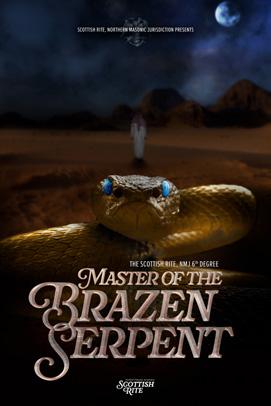




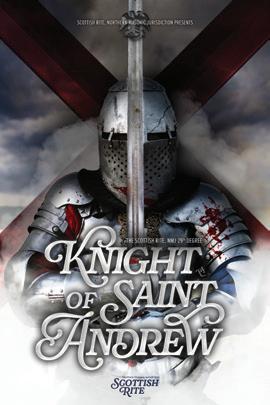

RITE CHARITIES












